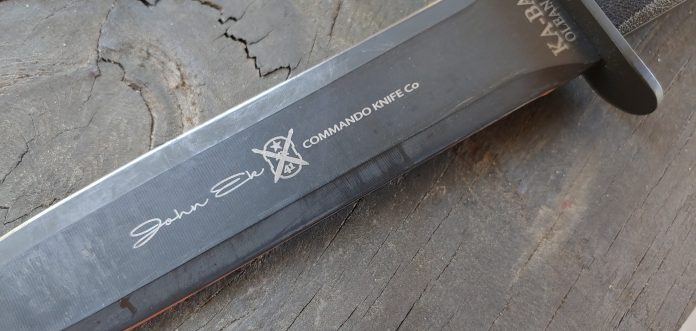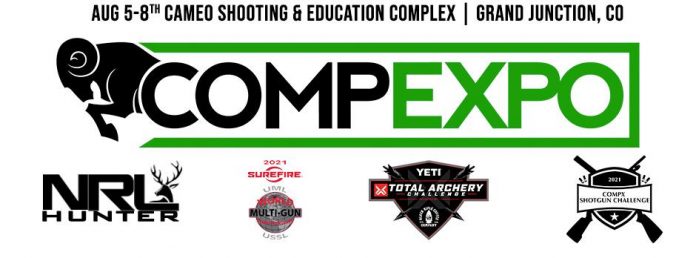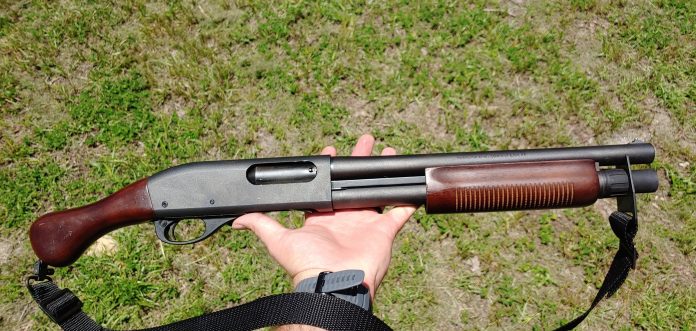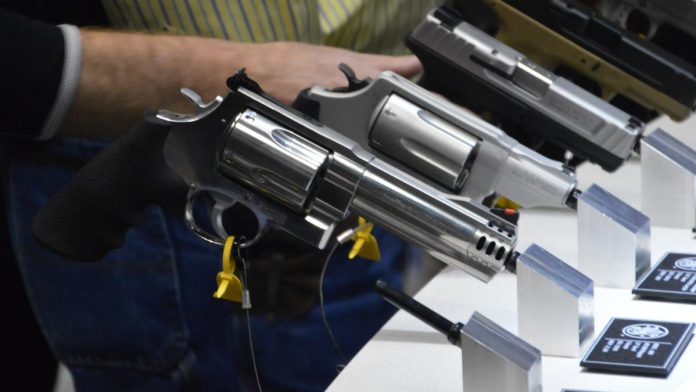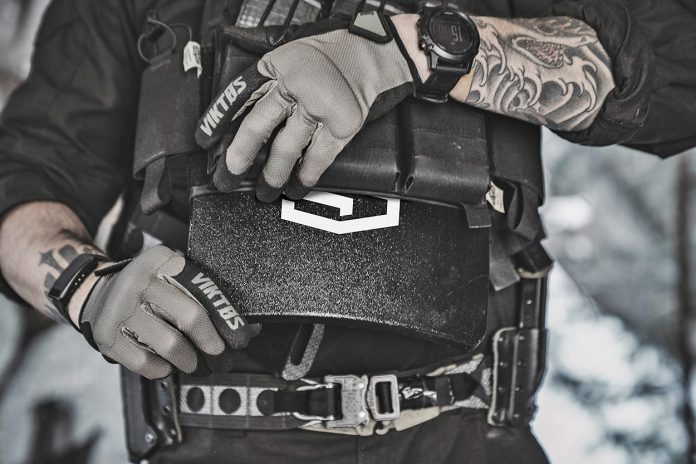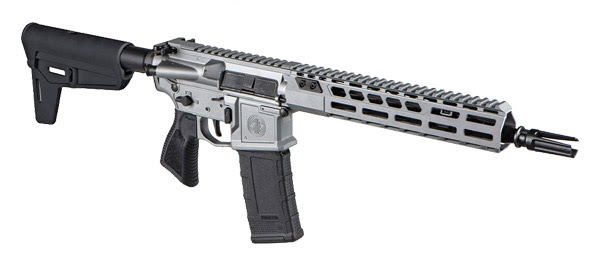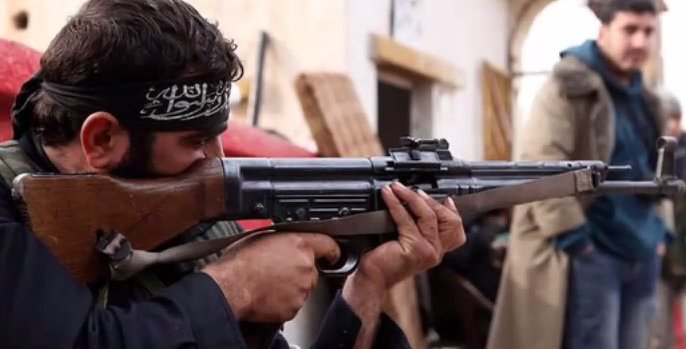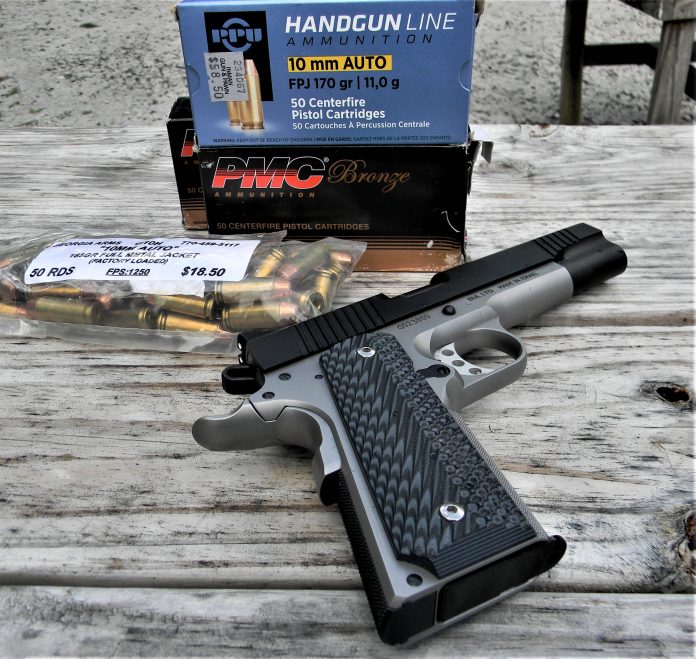The boys are back and they are talking some nonsense! Is every Marine actually a riflemen? Is everyone in the Army a soldier first? Is the Air Force even the military?
VHS-2 : But does it have a Gripzone?
The HS2000 is a famous and or infamous handgun in the states.
We know it as the XD, and it is an import of Springfield Armory first glimpsed during the striker gun days. That period of time where we saw the M&P emerge, the Gen 4 Glock, and the early (and gravity vulnerable) iterations of the P320. We have seen many iterations since.
It’s many variants are a popular handgun series, however the basic HS2000 design was a Croatian duty pistol and was an inexpensive addition to the U.S. Market that grew wings with the rebranding.
But HS Produkt, maker of the HS2000, is a full on military and police firearms designer/manufacturer and they competed to replace the aging FAMAS bullpup for the French military.
They submitted a replacement bullpup, however the H&K416 won ultimately.
But the rifle, the VHS-2 (no, it does not rewind) was the resultant rifle, Ian over at Forgotten Weapons got his hands on it and shot with it.
It looks like a G36 with a touch of IWI X95. It has a 40mm Grenade launcher as most infantry rifles do and is one of the first mainstream (ish) bullpups to offer an adjustable length of pull on the stock.
Most bullpups have a fixed length of pull as the action is housed inside the stock, crowding any mechanism that would otherwise allow adjustment. HS found a way to add some. They also made a fully-ambi rifle, to include selectable ejection, and different selectable magazine patterns.
All in all they produced a very solid modernization on the bullpup concept.
Of my personal criticisms, the only thing I can see on the design that I wouldn’t care for is the selector design and that could be mitigated by positive detent positions so that it is fairly difficult to go to full-auto (level) from the safe position which is at an upward 45 degree angle. It would all be in the detent feel.
What drives Trudeau’s campaign against guns?
[Ed: A Canada-focused, but a highly instructive piece from our Northern correspondents illustrating the many dangers of internationalist politics. Previously published in the Canadian Firearm Journal & minimally edited for DRGO; apologies for not having author information on Dr. Mauser’s co-author Joanne Eisen.]
“When politicians bloviate about a ‘higher purpose,’ it’s time to watch your wallets, hide the kids and lock your doors (front, back and refrigerator).” Michelle Malkin, columnist
Why has Justin Trudeau campaigned so devotedly against civilian firearms? The Liberals introduced Bill C-71 in 2018, next they prohibited thousands of firearms in a controversial Order-in-Council in May 2020, and now, Bill C-21 is working its way through Parliament.
Why? Research shows that armed civilians are a credit to the country; not just “law abiding” but community leaders and exemplary citizens. Facts cut no ice. Attempts to argue the facts with the Liberals fall on deaf ears. The Liberals hold fixed policy beliefs, after which they search for supportive factoids. This is a mockery of the ideal that public policy should be based on reality. The Liberals’ fixation on guns seems to be religious.
Admittedly, the Liberals campaign against civilian firearms is, to some extent, about winning elections, but it is also based on ideology. The Liberals are committed to internationalism and the dogma of collective security. This means trusting the state for protection, to “collective security.” Despite the Liberals’ claims, gun control is not about fighting gang violence, nor about protecting women from spousal abuse, the Liberals believe that firearms in the hands of civilians is a dangerous sign of “nationalism” and even threatens world peace. Far-fetched? Let’s look more closely.
First, consider electoral calculations: the Liberals think “gun control” appeals to young females in big cities, as well as immigrants, who are afraid of guns. Recent Angus Reid polls show that the strongest supporters of additional gun restrictions admit they know virtually nothing about guns or the current gun laws. Strategically, campaigning against “military-style assault rifles” puts the Tories on the back foot, forcing them to defend “assault rifles” in gun-phobic Toronto.
Behind this campaign strategy is an ideological abhorrence of armed civilians. To Liberals, firearms are symbolized by “military-style assault rifles.” Invoking the nationalist demons that cosmopolitans fear, gun owning civilians are called “right wing,” or “extremists,” or even “racists.”
The Liberals have long been committed to internationalism and the United Nations; they see national pride in Canada as undermining their internationalist dream of collective security. These beliefs are what drive Trudeau’s gun laws.
The Liberals are committed to the vision that universal disarmament will foster collective security. Not just nuclear disarmament, but their dream goes beyond eliminating military weapons, like tanks and howitzers, to include “small arms,” like hunting rifles and handguns.
Support for internationalism and the UN has grown into a quasi-religious tenet of the Liberals since Lester Pearson and the Peacemakers. Justin Trudeau would like to be seen as cosmopolitan, as a true believer in internationalist principles. He has made disdainful comments about Canada and Canadian cultural traditions, saying for example, that Canada is “post-national.” In 2016, Trudeau said, “There is no core identity, no mainstream in Canada.”
His scorn for Canada contrasts with his vocal praise of the United Nations for “laying the foundations for a rules-based international order,” and his support agencies such as World Health Organization and the UN Peacekeepers. Immediately after becoming Prime Minister, he made a Quixotic push to get on the UN Security Council, even though the chances were never good. In his recent address to the UN, he urged increased reliance on multilateralism and international law, the essence of collective security, in order to “lay the foundations of a better world.” Justin’s fawning efforts to impress UN functionaries illustrate his commitment to internationalism.
Driven by a wide-spread revulsion against nationalism, the UN was founded in the aftermath of World War II. The founders of the UN thought “collective security” would replace nationalism, which was seen as the driving force behind war, as illustrated by Hitler’s Nazis and Mussolini’s Fascists. World elites thought that international organizations could replace nationalism and thereby reduce populist forces that they saw as having driven the world into two world wars. The UN would create a rules-based international order, and perhaps in time, like the European Union grew out of the European Coal and Steel Community, the UN would become the nucleus for a world government.
The UN adopted the disarmament policies of the League of Nations. The primary goal is to prevent wars through collective security and disarmament; international disputes are to be settled through negotiation and arbitration. After the World War I, the League of Nations was set up to limit and reduce arms. Various naval conferences, such as the Washington Naval Conference, were held during the period between the First and Second World Wars to limit the number and size of major warships of the five great naval powers. In Japan, militarists saw these limitations as insulting and this spurred Japanese rearmament. The 1928 Kellogg-Briand Pact attempted to “provid[e] for the renunciation of war as an instrument of national policy.” Obviously, the League’s efforts failed to prevent World War II.
Despite the idealism of its founders, the United Nations has not had much success in limiting international conflict. The Cold War began even before the ink was dry on the UN Charter. The Korean War raged in the 1950s, and war in Vietnam first drove the French out in the 1950s, then sucked the US and their allies into the maelstrom through the 1960s and into the 1970s. The United Nations could not stop genocides in Cambodia, East Timor, nor the massacres in the Balkans or the slaughter of the Tutsis in Rwanda, to name just the most prominent.
Trudeau and the Liberals are proud of their commitment to the UN Peacekeepers. But the Peacekeepers have not just failed at resolving conflict, they have been caught causing serious crimes. The United Nations refused to accept responsibility, or to pay compensation, after UN Peacekeepers irresponsibly killed over 10,000 people by introducing cholera to Haiti. Not just once, but in many countries, Peacekeepers have been caught in corruption scandals and systematic sexual abuse rings.
Undaunted by its repeated failures, the United Nations founded the United Nations Office for Disarmament Affairs in 1998, initially to promote nuclear disarmament, but later the goals expanded to include disarmament of chemical and biological weapons as well. UNODA also promotes disarmament of conventional weapons, especially landmines and small arms, including hunting rifles and handguns.
The United Nations Arms Trade Treaty came into force in December 2014. So far, the ATT has been ratified by 110 nations. However, it is currently missing ratification by key arms producers such as Russia and China, and while the United States has signed the treaty it has not yet ratified it. The Arms Trade Treaty requires signatory nations to keep records of imported arms, including small arms, through to end use, claiming that this will “prevent their diversion into the illegal circuit, facilitate the investigation and prosecution of related offences without hampering legitimate transfers.”
In 2019, Canada became a State Party to the ATT. This means that Canada will be required to comply with all future firearms regulations that UN decides to impose under the treaty. In 2017, the Liberals amended Canada’s Export and Import Permits Act and the Criminal Code (Bill C-47) to harmonize Canadian laws with the ATT. The Trudeau Liberals see sacrificing Canadian sovereignty as just a small cost to protect human rights around the world.
The current Liberal gun laws conform with their campaign promises back in 2015. To some extent this is surprising, given how many of their other campaign promises the Liberals have failed to honour, from an open and accountable government to lifting all long-term drinking water advisories in the First Nations, but Trudeau and Public Safety Minister Bill Blair see gun owners as the perfect punching bag. What other issue allows Trudeau to pose as a “feminist,” scoop up the votes of ignorant urbanites, fawn on the international elite, and follow his ideological star?
.
.
—Gary Mauser, PhD is professor emeritus in the Institute for Canadian Urban Research Studies and the Beedie School of Business, Simon Fraser University, British Columbia. He specializes in criminology and economics, has published extensively on firearms legislation, firearms and violence, and has provided expert testimony on criminal justice issues to the Canadian government.
All DRGO articles by Gary Mauser, PhD
Your Silent Partner – A Booklet On Knife Fighting by John Ek
Recently I reviewed the Ek Model 4. This classic fighting knife has been rereleased by KA-BAR to allow the masses to embrace the classic Ek Model 4 dagger design. John Ek’s knives came to be during World War 2, where he famously only sold knives to troops. Not out of some sense of moral responsibility. He wanted to make as many knives available to fighting men as possible. John Ek also wrote a very short booklet on basic knife fighting called Your Silent Partner.
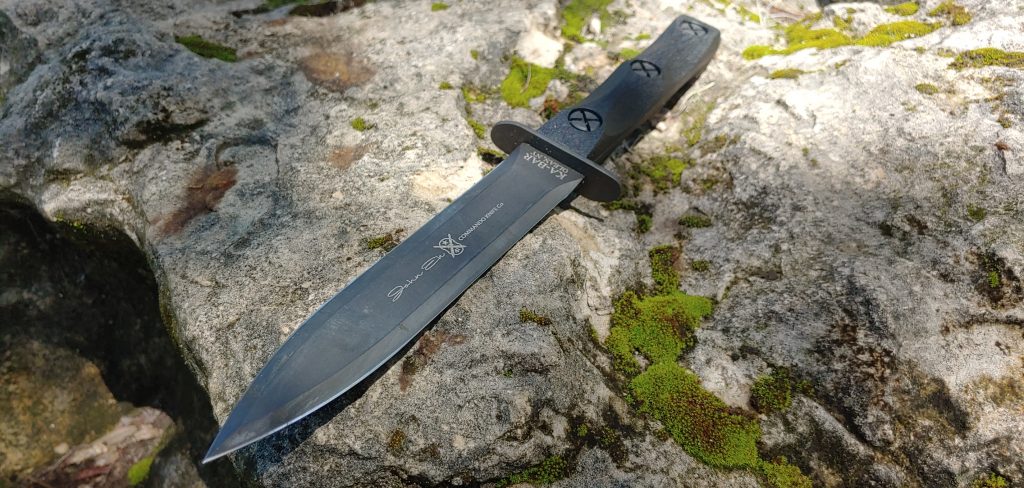
This short booklet contained some rudimentary knife fighting advice and basic techniques, and knife maintenance. It’s a quick read, and as a booklet intended for soldiers overseas, it doesn’t waste paper and ink waxing poetically. Your Silent Partner also contains a catalog of Ek Knives, and the process in which they are formed, made, and why they function so well in their jobs as fighting knives.
Who’s John Ek?
Obviously, he was the inventor and owner of Ek Knives. John Ek spent three years in the National Guard and seemed dissatisfied with the M1905 Bayonet as a fighting weapon. That drove him to create his own fighting knife. The book’s foreword quickly glosses over Ek’s dive into knives and knife fighting. He researched books, spoke with soldiers, Marines, and sailors, and dived deep into the subject before he ever designed a knife.

Your Silent Partner – A Booklet on knife Fighting was created solely for the fighting man going overseas. These days the booklet isn’t exactly sold on amazon, and I only learned of it through a reference at Wikipedia. I went on a Google quest, and it took me the third page of Google before I stumbled across a scanned PDF variant. The third page of Google is pretty far to hunt, but the copy remained readable, and I breezed through it.
Your Silent Partner – Book Review
In Ek’s introduction, he states, “This booklet has been prepared for and only for you men in the armed services.” While unintentional, I do like that this shows that back then, a whole county went to war, not just the armed forces.
John Ek goes into describing what a fighting knife should be. He describes the requirements and follows up with how the Ek knives fit the bill. After that, the book dives into how to use the knife and never stops.
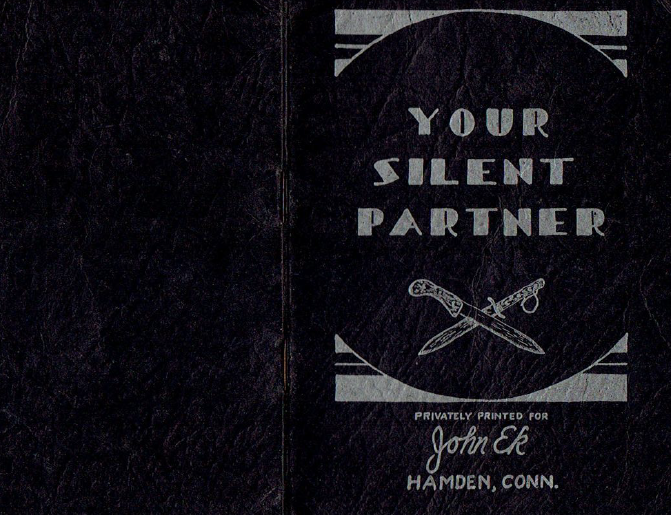
He sources advice from violence connoisseur Rex Applegate, a famed expert in hand-to-hand fighting. He adds his own touches and describes a very basic stance. It’s simple to read and digest, and again when you look at an American man heading to war, it makes sense. These guys didn’t have time to read a few hundred pages about knife fighting while storming Normandy.
Throughout the book, all the information is provided this way. It’s quick, easy to digest, and doesn’t ever get too deep into the woods. Heck, the book moves from stance to techniques and knife care without the need for chapter breaks. It’s meant to be read in one sitting, and the advice is simple enough to remember.
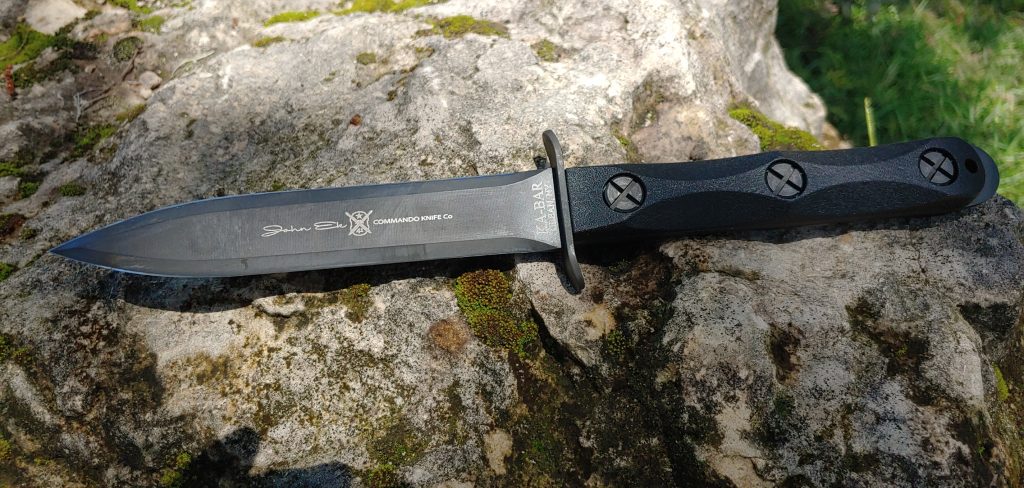
The advice targets not just the individual soldier, but plenty could be absorbed by the NCO who takes charge of his men. The physiological response to killing with a knife is addressed, as is advice on practicing the techniques from a logistical standpoint.
Practical Advice
The basic stance is slightly crouched with the knife in the dominant hand tucked in near the belt, and the left out and used to block, parry, and attack. Hell, throwing sand is an advisable tactic. The stance described is still used by the Marine Corps in their basic knife fighting skills.
Your Silent Partner dives into the weak points of the body and where a knife can do the most damage. Again, it’s all super easy to understand and something easy to remember. I read the book, and it’s easy to remember a stab below the Adam’s apple kills quickly. A cut across the bicep and wrist will disable an enemy effectively, and sentries can be disabled with a deep stab into the kidney area.
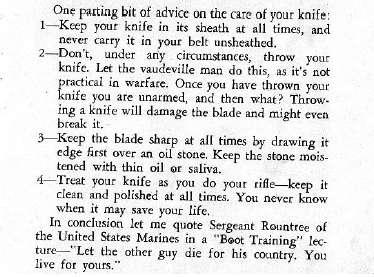
He even advises stabbing the kidney over trying to slice a throat to take a Sentry down, and realistically you can see why. Carving through a throat silently from behind takes time, skill, and stealth. A quick stab to the kidney is much quicker and easier to do without training.
Finally, we get to carrying the knife, and the advice could be taken from a book on concealed carry. It’s practical and advised ways to conceal the knife so the user can maintain their surprise. They also advise practicing drawing and consistently carrying in the same method.
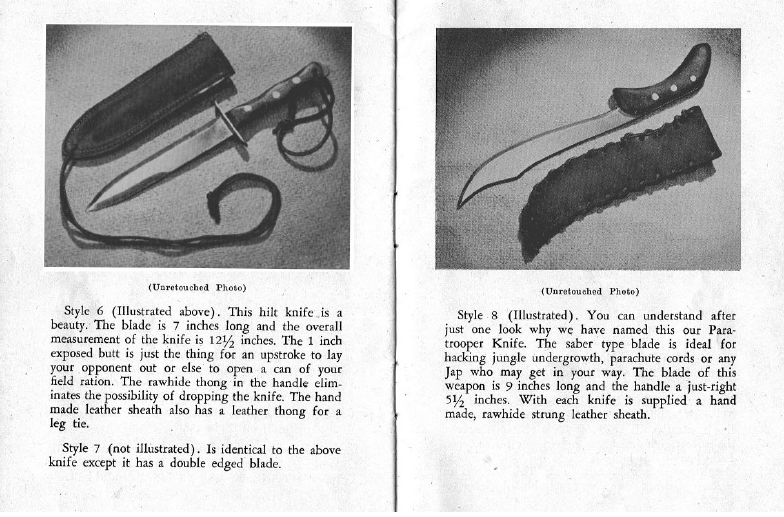
At the end of the advice, he offers four basic pieces of advice regarding care for your knife, don’t throw knives, etc.
Check It Out
I love books like this. Pieces of history that are relatively unknown but still valuable. Your Silent Partner offers plenty of advice. It’s quick and easy to digest, and the advice is still relevant if you find yourself in a knife fight. Plus, the end pages consist of a catalog of Ek knives, and it’s fascinating to see the various models and read their very un-PC descriptions. If you can find your way to the third page of Google, it’s a worthwhile read.
CompExpo
What is it?
The CompExpo is a multi-vendor and match expo being held in one of the leading shooting and archery complexes in the nation, the Cameo Shooting and Education Complex. Vendors will be set up holding live-fire demos, both archery and shotgun, answering questions, and of course giving away swag. While vendors are set up there will be numerous national level matches going on. These include the NRL Hunter Grand Slam, the Surefire UML World Multigun Championship, the Total Archery Challenge, and the CompX Shotgun Challenge. All competitors will be there early enjoying the vendors and shooting their matches on the same grounds. This is a huge opportunity for all of those that have may been interested in competing in certain shooting disciplines but haven’t taken the leap yet. You will be able to watch the matches and talk to competitors to see first-hand how these matches run.
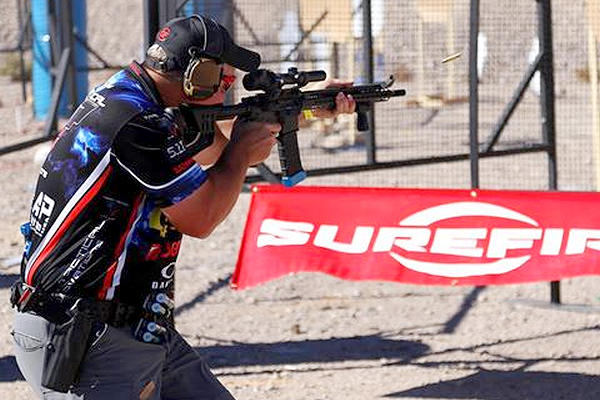
http://bulletin.accurateshooter.com/2016/10/world-multi-gun-championships-this-weekend-in-henderson-nv/

Nrlhunter.org
Exhibitors
- Burris
- Cole-Tac
- Field Optics
- The Guardian
- Kestrel
- Kifaru
- Leica
- MagnetoSpeed
- MC3
- National Rifle League
- Nightforce
- NSSF
- Proof Research
- SIG Sauer
- Timney Triggers
- Viking Armament
- Vortex
- Vudoo Gun Works
- XLR
- and more..
If you’d like to join the list please fill out an application here.
Open to who?
The CompExpo is open to the public and all competitors.
Dates and Location
The CompExpo will be held from August 6-8th at the Cameo Shooting and Education Complex Located in Grand Junction, Colorado.
Address: 3934 I 9/10 Rd, Palisade, CO 81526
Tickets
Tickets for general admission are only $20.00 and can be bought here. Every General Admission ticket comes with a raffle to win a prize from the sponsors. From experience, there are some pretty wicked prizes.
MCK/TAC: Newer (and smaller) from CAA
This new conversion kit from CAA, the MCK TAC, is a “Glock brace” (as occasionally described) that is actually compatible with 120 or more models of handgun. The new upgrade is an extension of the Micro Conversion Kit line. Available in a wide variety of colors and camouflage patterns, the MCK TAC is one of the smallest “PDW conversion kits” available yet
An MCK TAC retrofit conversion kit is also available (for a variety of different handguns).
That means that no matter which pistol magazines you use to feed your handgun, you’ll likely be able to make a PDW out of it.
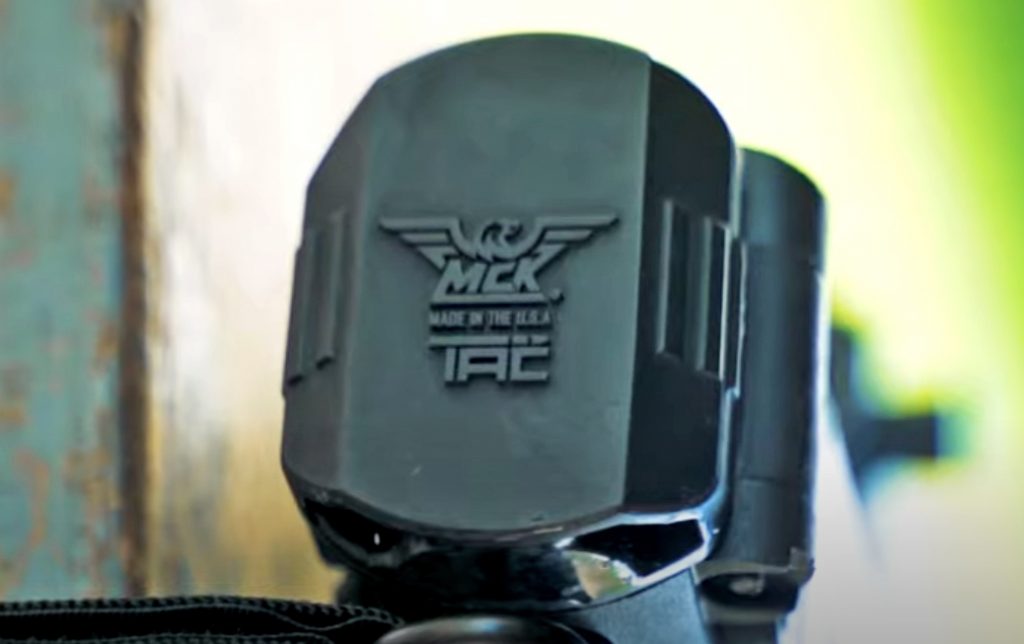
The MCK TAC is designed for close-in type defensive work (hence the PDW angle), including “close protection” (i.e. VIP/PSD uses), providing what is essentially an add-on shooting platform expansion. There is no stock on the MCK TAC as it is not intended to be shouldered.
Instead, it is stabilized (insomuch as any weapon using sling tension can be stabilized) as described by the manufacturer below.
- The MCK TAC ships with a special Bungee sling, sling swivel, and rail-mounted thumb rest for added stability when accuracy and control truly count.
- The combination of the shooter’s arm at full extension and the resistance from the bungee-style sling creates a steady platform for added accuracy and control when shooting the MCK TAC.
Installation is fast, simple, and largely intuitive (as Travis Pike has previously reported.
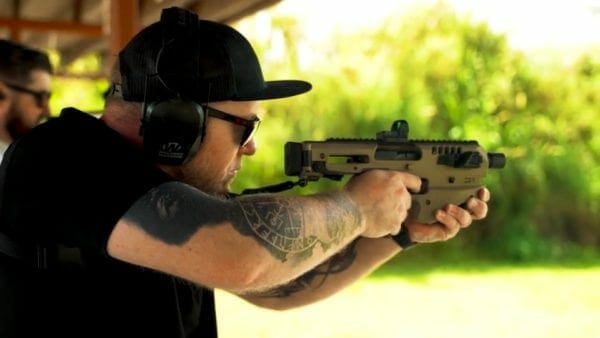

LTC. (Ret.) Mikey Hartman, CEO of CAA USA advises,
“Born out of demand by private and military security firms, we put our engineering team to work on creating the most compact and discrete MCK (Micro Conversion Kit) to date. Presenting the MCK TAC. The TAC is suitable for all real-time scenarios in which concealment and speed are paramount. Taking cues from the shooting dynamics of firearms like the HK MP5K, the MCK TAC, with included bungee sling and swivel is the ultimate compact shooting solution. Not only are we releasing the MCK TAC, but we’ve also created a TAC upgrade KIT to retrofit any existing MCK to the new TAC configuration. The TAC rear compartment keeps you in the fight by adding storage for an additional CR123 battery for your weapon light or optic, up to four 9mm rounds or even hearing protection.”
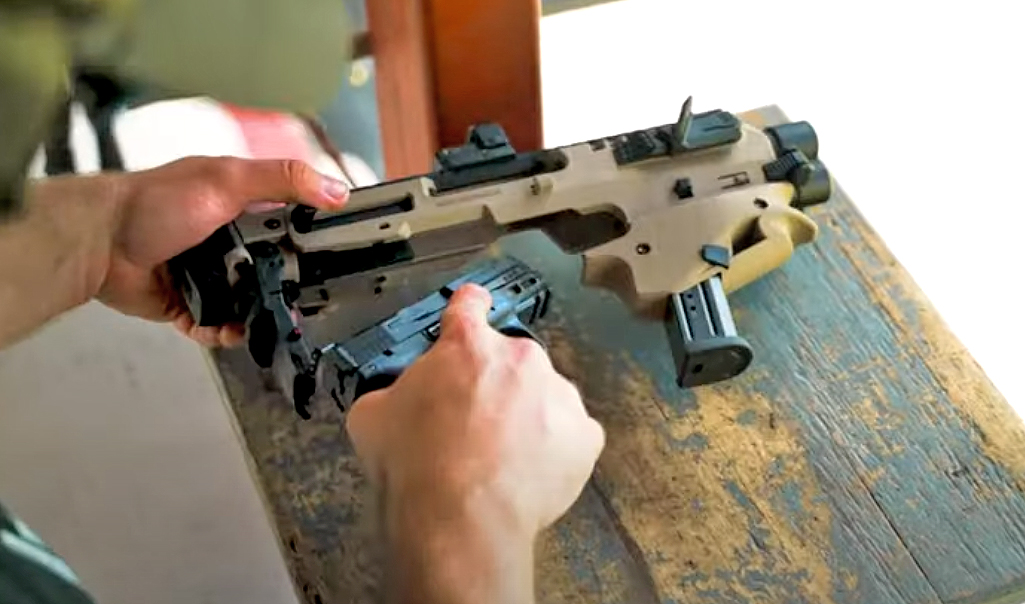
Sling Tension Shooting
“Sling tension shooting“, also referred to as the “SAS method” was first popularized (if that’s the right word) by images of the British Special Air Service, though other units have used it. Sling tension shooting is, as described above, a push/pull method.

MCK TAC
Rethinking the PGO Scattgergun
The Mossberg Shockwave and Remington TAC 14 series of firearms were massively popular a few years back. They remain popular now, but the novelty has worn thin a bit. If you’re not familiar with these two PGO firearms, they fall into the not-a-shotgun category. They have 14-inch barrels and a Raptor pistol grip that allows them to stretch out to at least 26 inches. These scatterguns replicate a ‘sawn-off shotgun,’ but due to their overall length and the fact they’ve never had a stock, they are not considered shotguns.
They are not shotguns, they are not pistols, and they certainly aren’t rifles. They fall into the ‘firearm’ category that’s essentially a catch-all for unusual firearms that do not fall into normal configurations. I love these PGO Scatterguns; I think they are a ton of fun, and the challenge they create makes them fun to shoot.
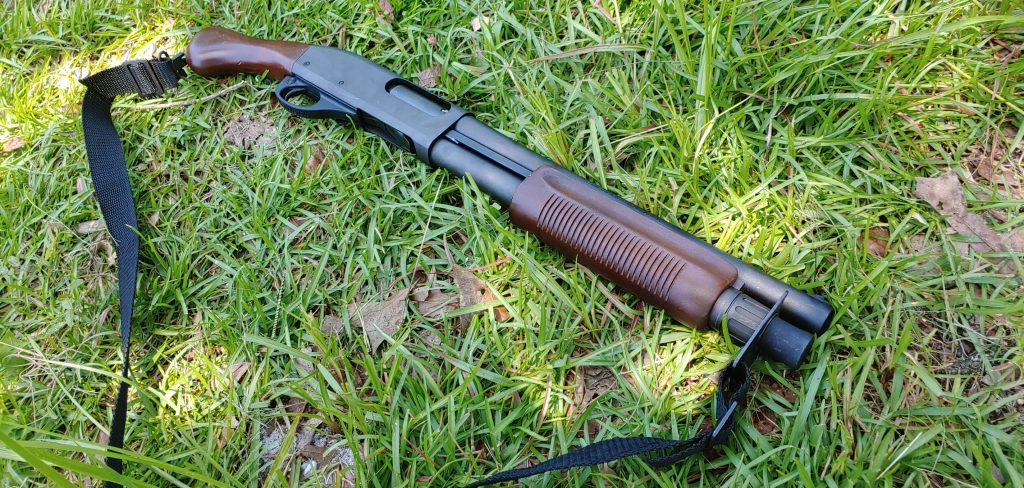
However, for the longest time, I thought they were basically useless. PGO Scatterguns were basically a fun range toy. My attitude on these firearms has shifted a bit lately. As always, I’ve been shooting a lot of shotguns and been heavily using the Rob Haught method of push/pull. I’m pushing forward with my dominant hand and pulling rearward with my dominant hand. This creates tension and reduces recoil.
As such, I noticed with a good push/pull, the stock barely has to grace my shoulder, and I could still be quite effective. That got me thinking, how effective could a PGO scattergun be in a practical scenario? I’ve always used the push/pull with my PGO scatterguns, but only recently have I gotten somewhat decent with the technique. (Don’t ignore shotgun dry fire folks.)
The Strengths Of A PGO Scattergun
Why the hell would you ever want a stockless shotgun over a stocked shotgun? Stocks are quite valuable for making that third point of contact on a firearm. However, when you trim the barrel and chop the stock, you get a very lightweight and maneuverable weapon.
At extreme close quarters, it flies on target. Going from the low ready to lead on target at close quarters is faster with a PGO Scattergun than a stocked shotgun. I took out a Remington TAC 14 and a standard Remington 870 tactical shotgun. I used the same ammo, and the same range, and the same target against a timer. My ammo was standard number 4 buck at 1345 feet per second.
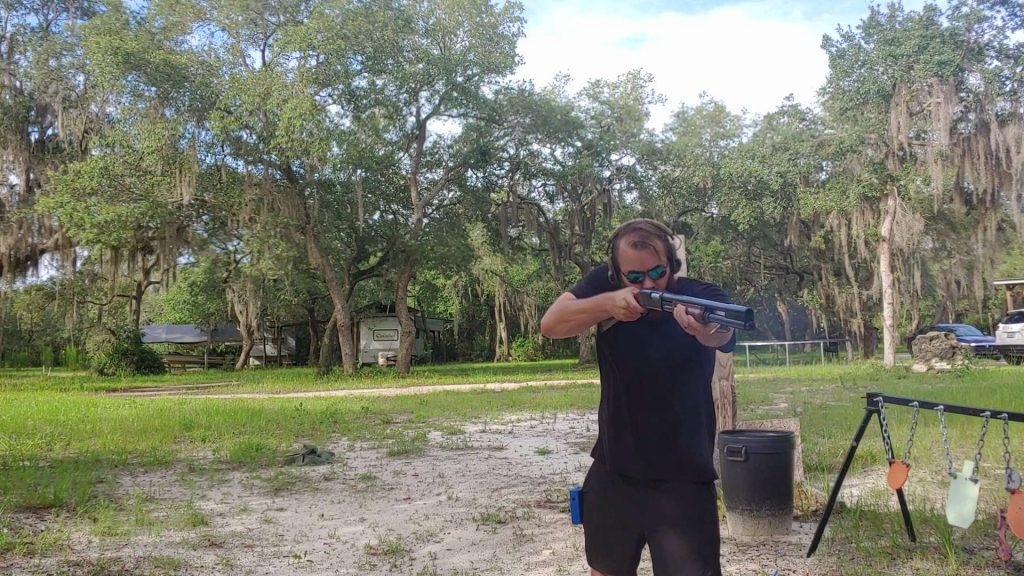
I did snapshots from the low ready measured by a shot timer. With the PGO Scattergun, I was able to get effective shots on target in under half a second. With the Stocked shotgun, my fastest time was .69, and with the PGO scattergun, my fastest time was .43 seconds. That’s a decent difference, and it comes from the fact that less shotgun is easier to swing up and target. No stock to navigate, no long barrel to swing on target, and it’s a shorter movement.
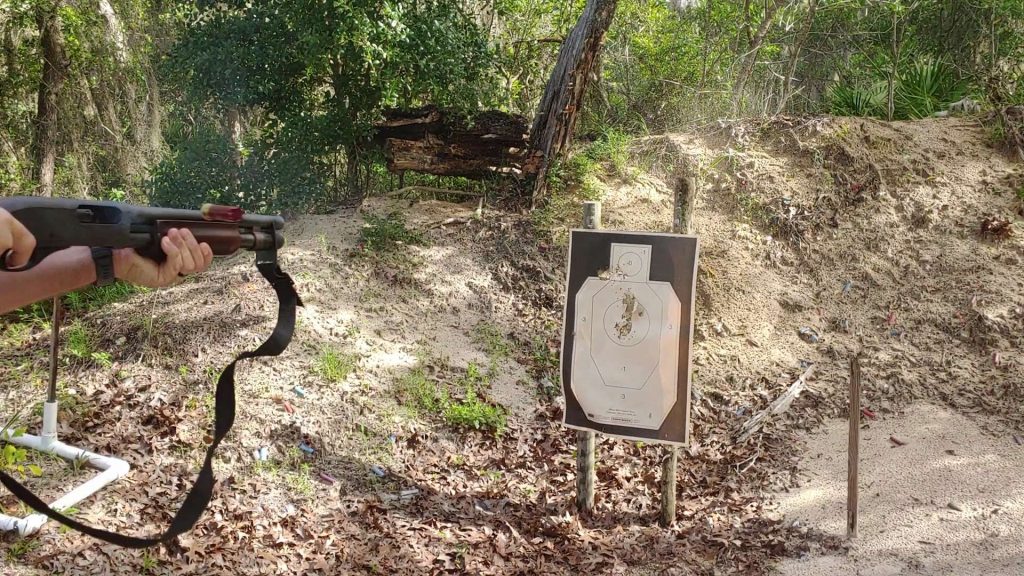
Being short makes the gun very maneuverable. Admittedly it shortens the range of an already short-range weapon, but in that quick, point-fire niche, it’s tough to beat. Sure, a handgun is even smaller and more maneuverable, but does it offer anywhere from 27 to 9 pellets of buckshot per trigger pull? At close range, you want the fight over as quickly as possible, and it’s tough to end fights faster than buckshot.
Where It Fits
If a Shockwave or TAC 14 can be an effective fighting weapon, where would it fit in terms of use? It’s a fair question, and civilian application is admittedly limited. By law, these weapons cannot be concealed, and concealment seems to be open interpretation, so it’s not something you’d wear under a trench coat or even keep tucked away in the truck for emergencies.
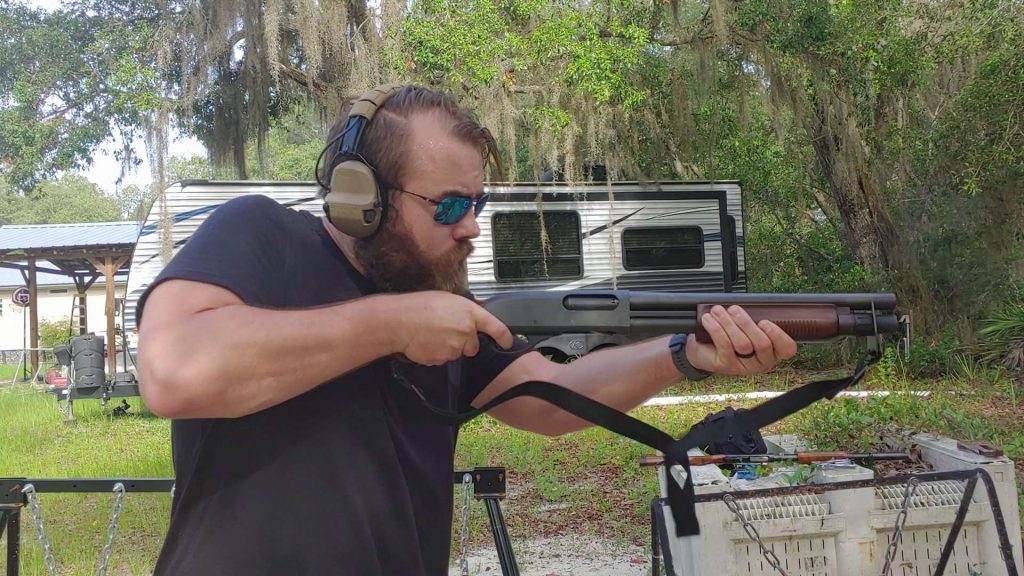
The U.S. Marshals created a short-barreled shotgun called the Protective Service Shotgun, and later, Bill Jordan created a commercial version called the Witness Protection Shotgun on this very gun. The Protective Service Shotgun was designed for protecting witnesses and high-value felons when used on the move. A PGO Scattergun works extremely well when you have to move in and out of vehicles.
It provides a piece of compact firepower that’s ultra maneuverable. Most of us aren’t U.S. Marshals protecting witnesses, but a PGO scattergun can still be used in similar situations. In the civilian realm, a PGO scattergun works extremely well inside a camper or an RV. I barely fit in these things, much less me and a shotgun or even a rifle. Heck, these would be great in a tent even.
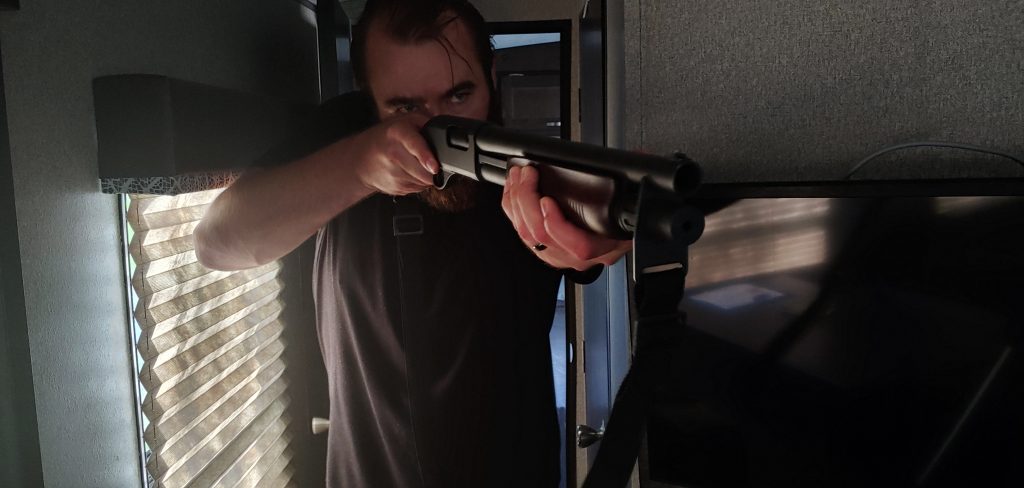
The PGO Scattergun gives me an effective weapon for these bad breath ranges inside these super tight quarters. If laws regarding what’s considered concealment and what type of firearm you can legally carry inside a vehicle weren’t around, I could see the PGO Scattergun being great as a ‘truck gun.’
Wildlife Defense
As a rural type, I could also see the PGO scattergun being handy for dealing with wildlife. A load of birdshot for snakes, buckshot for coyotes and hogs, and slugs fore bears. It’s super short and light and rides well on an ATV or side-by-side type vehicle. It allows for easy manipulation of the vehicle as well. I can grab it, aim, and fire it easily from a seated position on an ATV. Hogs and coyotes get an immediate death sentence from me, and being able to chase one down on an ATV and quickly take a shot is valuable.
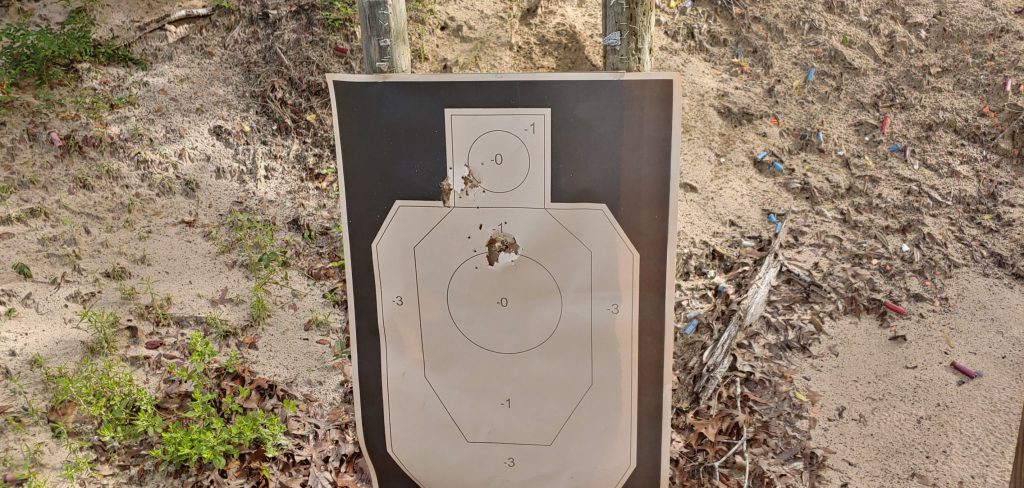
Home Defense
Admittedly I like a Benelli M4 for home defense, but I don’t think you’d be outgunned with a PGO Scattergun. It’s small like a pistol, and it’s easy to maneuver if you have to move from one room to the other. You can easily open doors and navigate around tight corners with ease. It’s easier than a traditional shotgun or a rifle and provides more gun than a pistol.
How To Be Effective With a PGO Scattergun
Any effective use of a weapon depends on your ability to handle it. That being said, the PGO Scattergun isn’t a gun for everyone. It does have a specific technique that requires some upper body strength to wield. Smaller and weaker shooters shouldn’t look to the PGO scattergun as a solution. It’s not fair, but neither is life.
To be effective with these guns, I do feel you need to use a good push/pull technique combined with an athletic stance. Your front hand does most of the work with the gun. You should be pushing forward with intensity as if you want to strike the target with the barrel. The rear hand pulls back and keeps it under control. You should feel it in your shoulders.
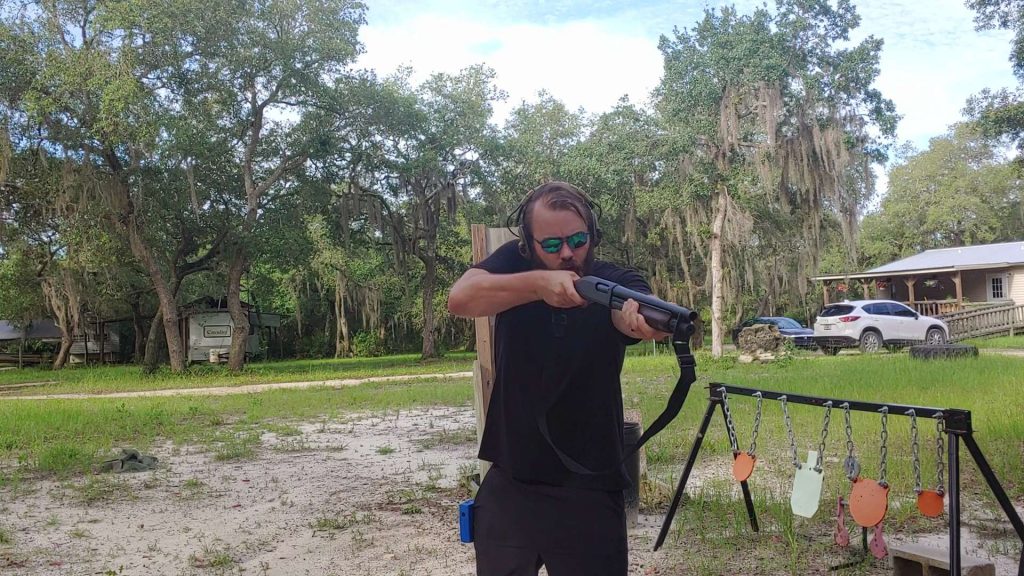
You want a tight grip on both parts of the gun. If your forearms aren’t engaged, you aren’t gripping tightly enough and will lose control. Shooting gloves help, but can’t do all the work.
Lastly, choose reduced recoil ammo. I use Flitecontrol, but I mostly train with birdshot, followed by full-powered buckshot. When I move to reduced recoil loads, I have zero issues controlling the gun. I would even say those 2.5-inch shells from Nobel sport might be a good choice. They offer six pellets of buckshot, function fine in pump guns, and allow you to pack one extra shell.
What About Stocks
The PGO Scattergun will never replace a dedicated fighting shotgun equipped with a stock. A stock allows you to maximize the range of a shotgun. A stock makes it much easier to reload the gun, and stocks reduce the margin of aiming error and improve consistency. A stocked shotgun will always be the go-to war option.
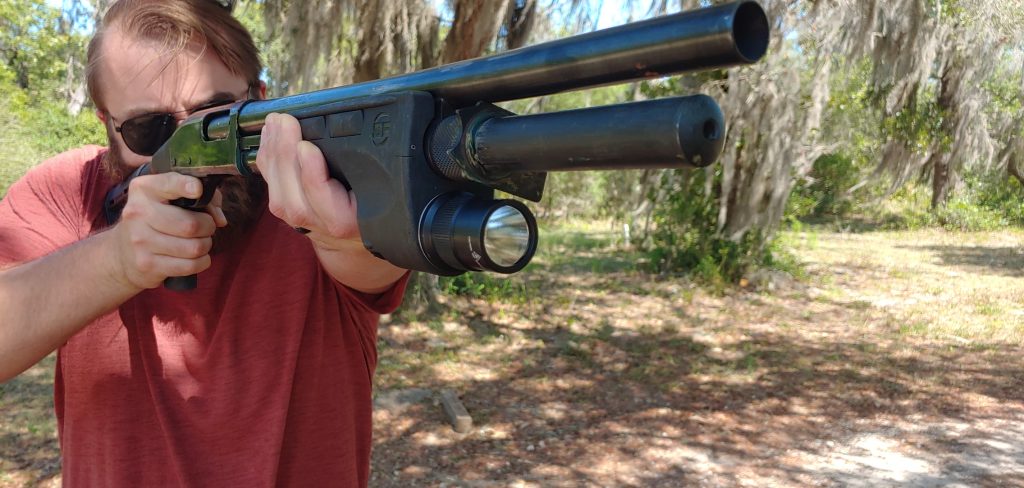
A PGO Scattergun fills a gap between the pistol and the long gun. It’s not quite either, but it packs the features of both. It requires a good amount of practice to be effective with and training to maintain those skills. In that gap, it’s tough to beat when you need a light, maneuverable, and powerful weapon.
How the AR-15 works.. to AK folk
Brandon attempts to explain the magic of the AR-15 to a contrarian internet. The funny part about how the AR-15 is both a piston and not a piston rifle depending upon how pedantic you want to be. We’re half way through the week. Smile. Have a little fun for a few.
The devil is in the details, the Direct Gas/Direct Impingement system feeds has to the bolt. That’s what differentiates it from the conventional pistons, both long and short, that vent the gas near the gas block. Honestly, if you call a DI AR ‘well actually it’s a piston’ I just know you watch Forgotten Weapons.
You should continue to watch Forgotten Weapons. But perhaps we should dial back on situations where we know what people are talking about. I’ll say magazine, if they keep saying clip it is no skin off my nose. I’ll say DI or Gas AR and someone else can say ‘technically a piston’ and sure, I will still refer to them as DI or gas because that is the common parlance of the base operating system.
Below is an excellent animation on how the AR-15 works in a more academic commentary.
Fourth Circuit Restores Adult (18+) Gun Rights
If you’ve purchased a handgun since 1968 you’ve known that the age to buy from a federal dealer is 21. That was in the 1968 Gun Control Act and has been one of the few federal deviations from the age of 18 for rights in the nation. 18 year olds can own a handgun, it is perfectly legal. But they were required to buy it on the secondary market. This ridiculous division of legal to own but not legal to purchase from the safest place to purchase, a licensed dealer, stood for many years.
The constitutional right to bear arms enshrined in the Second Amendment should apply to those between the ages of 18–20, declared the U.S. Court of Appeals for the 4th Circuit in Hirschfeld v. Bureau of Alcohol Tobacco, Firearms and Explosives.
Tanner Hirschfeld and Natalia Marshall challenged the constitutionality of federal laws that ban federally licensed firearm dealers from selling handguns and handgun ammunition to 18–20 year olds. This is the second major ruling against the 1968 Gun Control Act.
Hirschfeld is now over 21 but Marshall is not, that is how long these court cases can take with the appeals process. Marshall felt she had convincing reasons to be able to legally buy a gun from a licensed dealer, including an active protective order against an abusive ex who had himself been arrested for unlawful possession of a gun. Her job as a horse trainer also has her often in faraway rural areas dealing with strangers. She wants, and thinks she should be able to easily and legally purchase from a licensed dealer, a handgun for her protection.
This is consistent with a logical application of the legal rights, as possession and purchase of a handgun by an 18-20 year old is perfectly legal. What wasn’t legal, for no explicable reason than the raw assumption that 18-20 year olds are too high risk to purchase a pistol but only from federal dealers, was the safest possible transaction to get a handgun.
The three-judge panel of the 4th Circuit, in a 2-1 decision written by Judge Julius N. Richardson, saw no particular reason why that age group of adults should lack the same Second Amendment rights possessed by those aged 21 and over. “Our nation’s most cherished constitutional rights vest no later than 18,” the ruling said. “And the Second Amendment’s right to keep and bear arms is no different.” Individuals over the age of 18 “enjoy almost every other constitutional right, and they were required at the time of the Founding to serve in the militia and furnish their own weapons.”
18-20 year olds do not face fewer threats than 21 and up adults, as pointed out they are of military age and could be required to furnish their own arms in a militia or posse call up. The reason behind the prohibition of 18-20 federally was that the government at the time could only influence federal dealers rules without violating the 2nd Amendment too grievously. To blanketly prohibit, which is what they would have preferred, would not have stood up like a federal dealer prohibition. They could ‘hide’ that as rule of commerce rather than a 2A violation.
Thankfully that appears to have come to an end, even before it hit SCOTUS. This is a significant positive move.
ShotStop Releases “Ultra Light” Rifle Plates
ShotStop has announced the release of armor they characterize as “ultra-light” Level IV HA Armor Piercing Advanced Body Armor Plates. ShotStop is a ballistics company headquartered in Stow, OH.
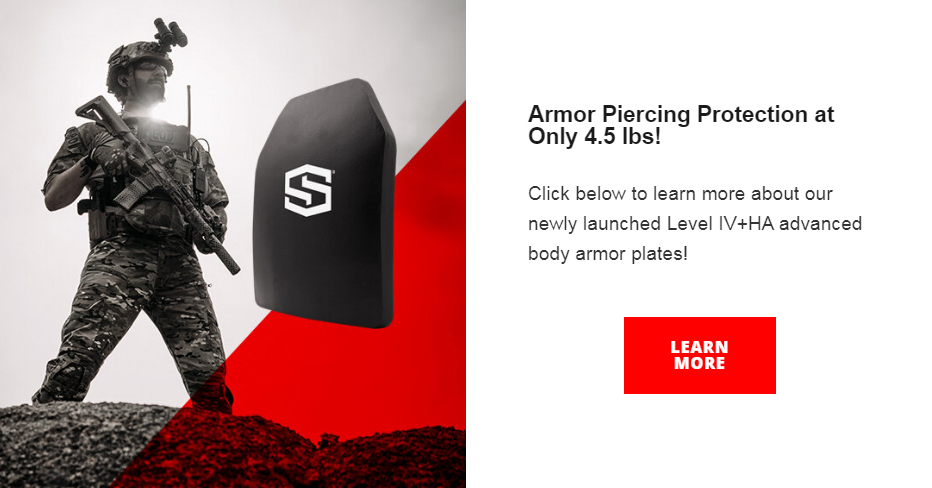
ShotStop says,
“What makes this an industry shattering announcement is the unprecedented weight for Level IV protection, weighing in at 4.5 lbs (2.0 kg) with a low profile of 0.9″ thick, these multi-curve, stand-alone, multi-hit plates provide the lightest armor-piercing protection in the world. The plate will provide the operator comfort, better mobility, and all the confidence to carry out their mission whether they are Military, Special Forces, SWAT, or Law Enforcement.”
Jason Henkel, Director of Operations at ShotStop, says, “Protection is absolutely ShotStop’s top priority, but being able to increase comfort, mobility, and advanced unique applications really differentiate this launch from others. Our new Level IV plate is positioned to dramatically change the way in which personal protection can be utilized in various environments and circumstances.”
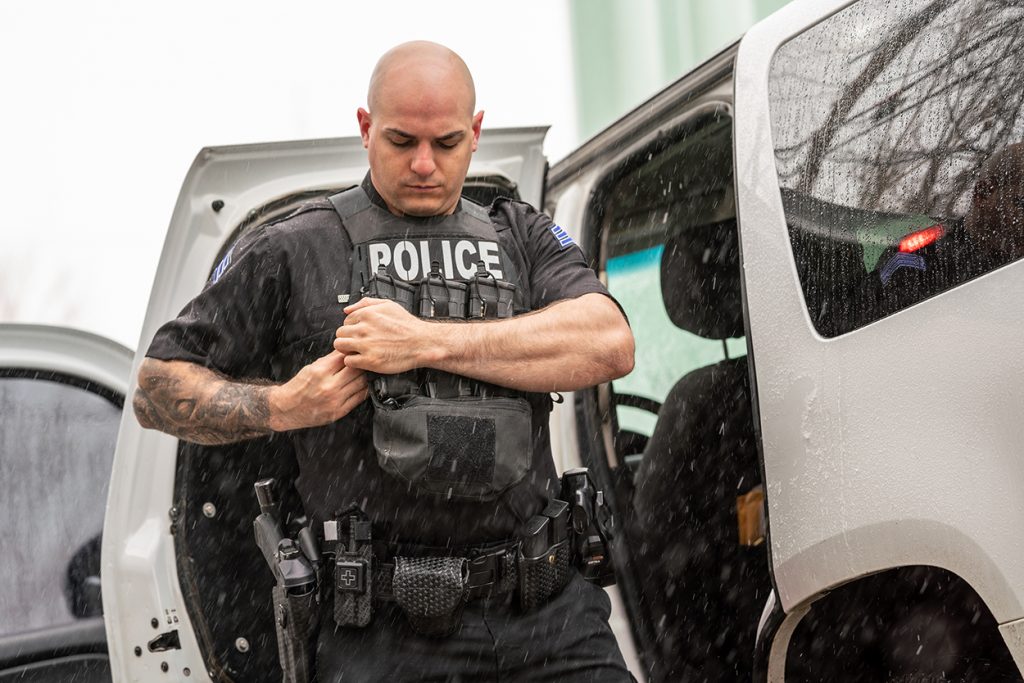
The new ShotStop ballistic armor plates are available in the following Shooter Cut and SAPI cuts and the following sizes:
6” x 6” x .9”
8” x 10” x .9”
8.75” x 11.75” x .9”
9.5” x 12.5” x .9”
10″ x 12″ x .9″
11″ x 14″ x .9″
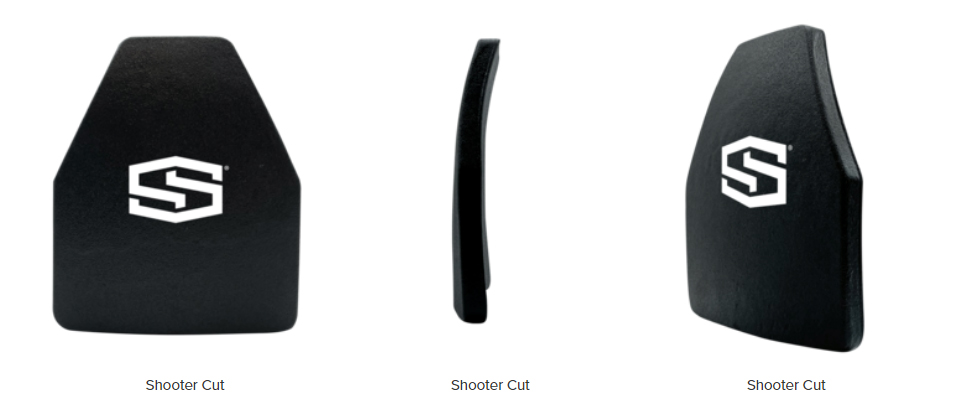
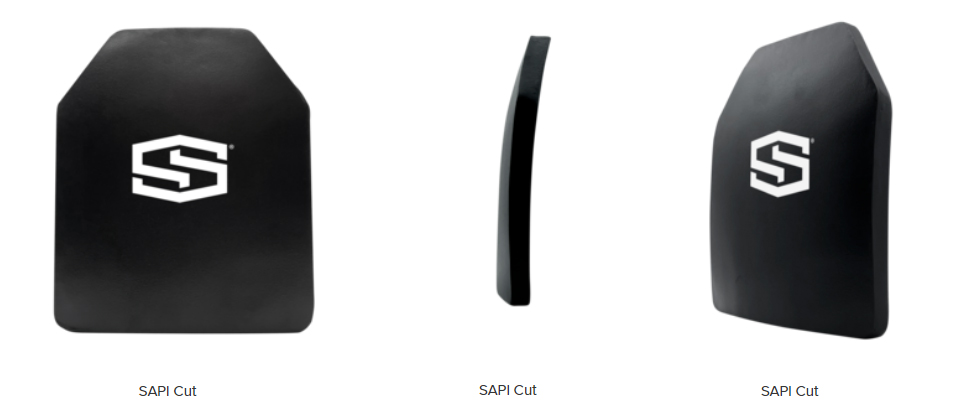
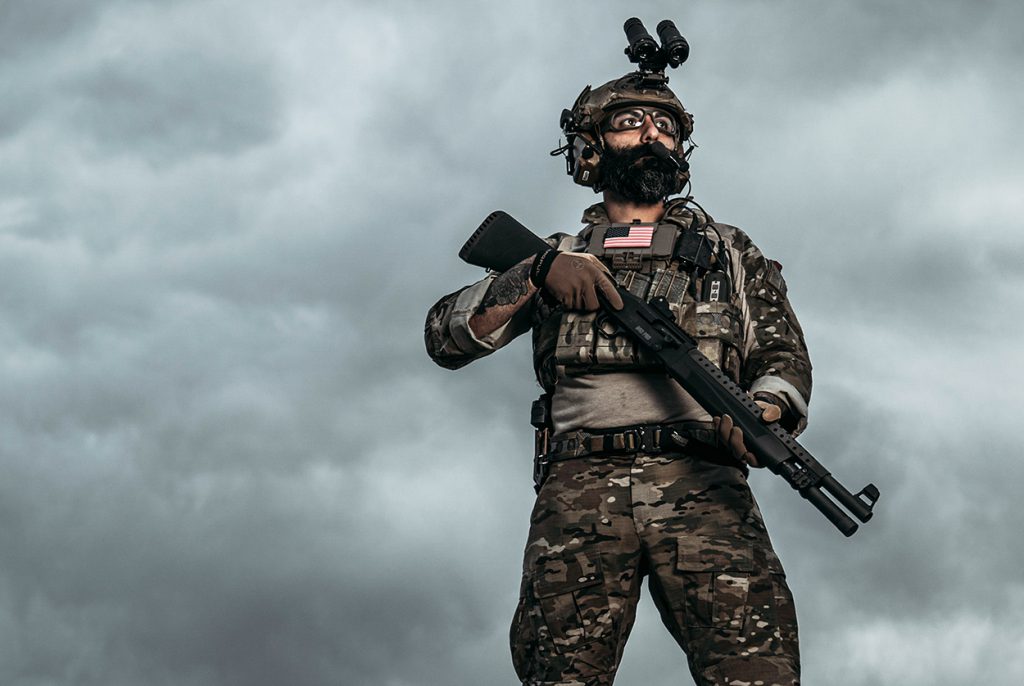
Read the remainder of the release after the video.
Threat Level Protection
The National Institute of Justice (NIJ) states that level IV armor must stop a single hit of 7.62MM AP. ShotStop’s HA Level IV ballistic body armor, made with patented Duritium® technology, is multi-hit and can defeat special threats including: 5.56x45mm 55 grain ball (M193), 7.62x39mm PS ball (MSC), 7.62x51mm 149 grain M80 FMJ, NATO M855 (SS109) 5.56x45mm 62 grain steel core (SS109), M855 A1, 7.62×54mmR Dragunov, and 7.62x63mm M2 AP.
The plate is currently pending testing to be listed with the NIJ.
Ounces Equal Pounds, and Pounds Equal Pain
Improving on the current HS Level IV model plate, ShotStop reduced the weight from 5.3 lbs to 4.5. When pounds equal pain for the operator, every ounce matters. Typical heavy body armor increases the amount of pressure on the joints, causing fatigue, pain and long-term medical issues. ShotStop’s Level IV plate gives the operator maximum mobility and while reducing weight-displacement injuries which are typical from heavy steel or ceramic Level IV plates.
“The accumulated reduction in knee load for a 1-pound loss in weight would be more than 4,800 pounds per mile walked,” says researcher Stephen P. Messier, PhD, of Wake Forest University. So, if a person was carrying 10 pounds less weight, “each knee would be subjected to 48,000 pounds less in compressive load per mile walked.”
Industry-Leading 10-Year Warranty
Along with the armor-piercing protection, the HA1RF3MC model comes with an unprecedented 10-Year warranty, translating to an unusually low total cost of ownership for the highest quality level IV plate available. Standard level IV ceramic body armor is only warrantied for 5 years. Unlike ceramic plates, which can crack when dropped, ShotStop’s proprietary composite plates do not need MRI/x-rays to monitor the plate’s integrity throughout the industry-leading warranty period. ShotStop’s plates can take a beating from everyday wear & tear and mishaps like drops, without ever compromising protection.
What is Duritium?
Duritium is a portfolio of technologies including a proprietary formula of Polyethylene fibers or ultra-high molecular weight polyethylene. These polyethylene fibers are woven and stacked by a computer navigated layering process at particular angles which elevate the ability of the armor system to more efficiently diffuse kinetic energy during ballistics impact. The stacked polyethylene is then vulcanized under 5000 lbs. per sq. inch presses while going through various high heat and cold cycles to form the base of the Duritium body armor.
Depending on the threat level requirement, the armor system can then be combined with ShotStop’s proprietary alloy composite which offers even further weight and thickness savings compared to other competitive armor options, especially at the higher threat levels.
ShotStop is online at shoststop.net. You can follow them on social, @shotstopbodyarmor on Instagram or /shotstopballistics/ on Facebook.
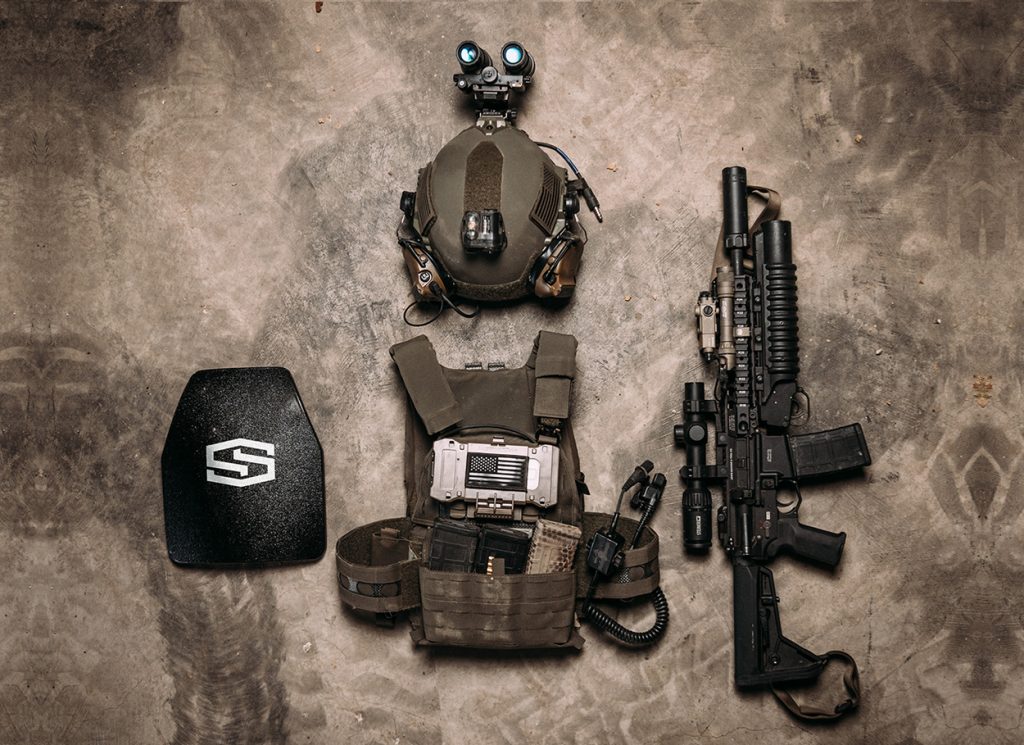
Blaser Introduces the R8 Rifle in 6.5 PRC
San Antonio, Texas (July 13, 2021) – Blaser is pleased to now offer its iconic R8 modular rifle in a 6.5 PRC chambering. Known for its accuracy and long-range performance, the 6.5 Precision Rifle Cartridge is essentially a magnum version of the 6.5 Creedmoor with a flatter trajectory and higher impact velocity making it a favorite of long-range hunters.
The straight-pull R8 bolt-action rifle, renowned for its reliability, repeatability, speed, and precision, offers hunters a vast number of configurations to meet their needs in the field. Options include a wide array of stock options, a recoil reduction system, adjustable comb, adjustable length of pull, and numerous barrels and bolt heads to facilitate quick conversions to different calibers, depending on the type of game one is hunting.
“If you combine all the different standard options on an R8, you can build over 47 million unique rifles and that does not even include custom shop options,” said Jason Evans, CEO, Blaser Group. “The interchangeability makes it incredibly easy to convert your rifle from one caliber to another by simply switching out the barrel and bolt head. This can be done in less than a minute. The engineering and craftsmanship is so extraordinary, after any barrel change, the rifle will shoot to within 1/2 MOA every time.“
The compact overall length and modularity of the Blaser R8 offer distinct advantages to hunters who travel frequently, allowing them to carry one rifle with several different barrels instead of transporting multiple guns around the world. The Blaser Saddle Mount system allows for easy and precise mounting of a riflescope by allowing the one-piece base of the mount to fit into notches machined into the top of the free-floating barrel. The barrel and saddle mount become one accurate unit, ensuring absolute repeatability once the scope has been zeroed, regardless of how many times the scope is removed from the barrel. The R8‘s concentric locking lugs with 14 locking surfaces provide 360-degree enagagement, further enhancing accuracy. This rifle also features one of the safest actions in the world thanks to its highly-acclaimed manual cocking mechanism.
The R8 is available in numerous calibers from 204 Ruger to 500 Jeffrey. For more information visit www.blaser-usa.com.
About Blaser Group
The Blaser Group is the official U.S. importer for iconic German firearms brands Blaser, Mauser and J.P. Sauer; English gunmaker John Rigby & Co.; and Minox optics and Liemke Thermal Optics. Established in 2006, the company which is based in San Antonio, Texas works with distributors, wholesalers, and over 200 authorized Blaser Group dealers across all North American states, with this figure continually growing. Today the Blaser Group’s industry-leading product portfolio includes bolt-action, combination rifles and over-and-under shotguns designed specifically for game hunters and competitive target shooters. Its custom shop offers exclusive engravings, design work and custom finishing for bespoke guns. With recent innovations, Blaser Group has gone on to expand its product portfolio into cutting edge optics and accessory lines. For more information about the company and product lines, visit: www.blaser-group.com.
Broad Topics, Narrow Views
Reaching as high as he can, the prisoner grabs the bars on his dungeon’s window. He pulls himself up, looks out, and sees a broad vista of hills, lakes, forests, fields and villages. But he can only hold this position for a moment, and then slides back into the dim light and dank walls of his confinement.
This describes the authors of “Mental Illness, Mass Shootings, and the Future of Psychiatric Research into American Gun Violence” who at several points take a wide view of the problem of violence, but for the most part myopically focus on “gun violence.” And of course, they fall into the usual logic trap of seeing guns as things having agency, rather than being tools of those who commit antisocial acts or who wish to end their lives.
The paper tells us there’s an epidemic of guns running amok, which is an odd perspective given that the number of homicides in the U.S. has been declining for decades, and our population rate puts the U.S. murder rate below average rather than above other countries.
The authors present at face value results of a study that purports to show that for 71% of adult Americans, mass shootings are “a significant source of stress in their lives.” Every workday I hear from patients about the stresses in their lives involving lack of money, unhappy relationships, their own or family members’ poor health, children’s behavior, friction at work–the list goes on and on–but I’ve never had anyone mention fear of mass shootings as a significant source of anxiety.
To their credit, the authors do note that “mass shootings are still rare events.” At their best, they suggest drawing from a number of different fields to improve understanding as to why violence arises and what might be good approaches to reducing it. In particular, they refer to interpersonal interventions that can be effective in this regard. For example, non-profit community agencies can contribute. In this context, they might also have noted a similar report alluded to in this column several months ago. [Which is this? Need to reference it.]
Although it is not clear what their term “cultural scripts” might mean, judging from the context they seem to be saying that there may be attitudes and misperceptions that dispose us to violence which might be changeable. This thesis seems reasonable and attractive, in that it suggests that things can be done to reduce underlying causes of violence.
Mental illness gets touched on at several points but, not surprisingly given the complexity of the issues, the authors never focus these thoughts. Early on they cite “serious mental illnesses such as schizophrenia” while later it’s “paranoia, depression, and delusions.” Still later we’re told about “clinical symptoms and affect patterns”, “acute psychosis or serious mood disorder”, and “paranoid delusions with hostile content”, as well as “substance intoxication” and “illicit drug use.”
Conspicuous by its absence is Antisocial Personality Disorder. This is frequently seen in violent actors, and the criteria for its diagnosis specifically include illegal acts and aggressive behaviors.
There are other inconsistencies in the paper. While advocating for more research into causes of violence and ways of addressing them, they disparage as “superficial” a research report showing that patterns of violence in the city (and so potential causes) differ from those in suburbia.
Strangely, they talk about the coronavirus pandemic producing a sharp increase in “the psychological determinants of injurious behavior” when it has been widely reported that suicides in the U.S. have declined since the pandemic began.
Not surprisingly, given the tenor of the paper, they talk about “gun violence” [sic] as a public health problem. Is freedom of the press a public health problem because people get bad medical advice from newspapers, because they act on current recommendations that later prove to be incorrect, or because they make bad decisions regarding health insurance based on misleading ads? Should freedom of the press be abolished in order to protect the public health?
The “public health” approach to “gun violence” promotes infringement of the 2nd Amendment no less than these ideas would the 1st Amendment. The point of research like this is from the outset targeted toward demeaning, diluting and diminishing Second Amendment rights.
On a positive note, the authors are correct when they say, “Psychiatry stands to be an agent of change in promoting interventions and solutions for improving the health of a community, rather than narrowly addressing the most sensationalized manifestations of gun violence.” That’s how it’s really done if we truly want to contribute to reducing violence.
.
.
—Thomas E. Gift, MD is a child and adolescent psychiatrist practicing in Rochester, New York, an associate clinical professor of psychiatry at the University of Rochester Medical School, and a Distinguished Fellow of the American Psychiatric Association.
All DRGO articles by Thomas E. Gift, MD
Sig M400 Switchblade
I really am over the “tough guy” naming conventions of the big manufacturers. But hey, it’s their product. I just talk about them.
Switchblade? Nothing on this little guy even folds. Names are hard sometimes, I guess.
The new M400 Switchblade brings a whole new level of performance to the M400 product family. Utilizing the uniquely designed ambidextrous bolt catch and release lever the M400 Switchblade gives you unmatched flexibility and capability. The Switchblade features an 11.5” barrel and Magpul’s all new BSL brace for maximum performance and control, it also features full ambi controls, twin locking clamp handguard, match grade flatblade trigger and a Cerakote titanium finish.
Cool.
It’s another 11.5″ DI AR-15, this one is ambi like ADM, Radian, LWRCi have been doing. It’s a proven formula and following the current carbine trends. Stainless steel in the barrel though, interesting choice but far from unheard of. A super easy SBR candidate with a stock swap.
That’s it, it’s a commercial CQBR URG-I peer. I’d have called it the M400CQP.
All in all, Sig looks like they’ve produced what they are known for producing, a solid firearm from a proven working concept. The rebirth of Sig’s product line after the interesting days of things like the ‘556’ which barely worked has been a welcome one.
The VIRTUS is one of the finer 5.56 rifles available. The P320, AXG, and Legion lines along with the remaining classic 226, 229, and 220 sku’s are continuing to provide satisfied customers with satisfactory firearms.
This appears to be more of the same.
I am amused they grabbed a .300BLK mag for this picture. Not that it wouldn’t function, just a detail I find entertaining. Their odd little rattler grip is always aesthetic.
Conclusion: Probably another solidly working short AR in the spirit of the current CQBR URG-I style. It will have some of the Sig idiosyncratic ancillaries, like the tapered barrel, but Sig likes taking care of the end user as much as feasible out of there stock instead of relying on aftermarket.
I’d change the grip to a B5 or a BCM and call it a good day. Throw on a R4T dot, a good light, go forth and pew. Simple.
Now I resume my NGSW info watch. That ambi bolt catch is a carryover from the SPEAR design too, I’m hoping it makes its way into the VIRTUS line.
Weird Weapons In the Syrian Civil War
The war in Syria has been waging for several years now, and as usual, the U.S. has gotten itself muddled into it. The war is a confusing one that features ISIS, Syrian rebels, the Syrian Arab Army, the Syrian Democratic forces, Russian mercenaries, and a variety of U.S. personnel. I’m not an expert on the war, but I am an expert in weird weapons. Well, not an expert, but a gleeful observationist.
Weird Weapons In Syria
What I’ve found fascinating is the completely bizarre variety of firearms that have found their way to the war in Syria. We expect to see Soviet small arms, domestically produced Middle Eastern firearms, and some U.S.-made guns. We’ve seen that, but we’ve also seen a variety of weird weapons pop up in the hands of a wide variety of Syrian forces. Some are historical, some are utterly random, and some reek of some kind of criminal element bringing guns into the country.
I’ve found what I think are the top five Weird Weapons in Syria.
STG 44
The world’s first assault rifle, created by the Nazis, has found its way into the hands of the Syrian Armed forces. Not just one or two, but 5,000 of these weird weapons leaked their way into the hands of the Free Syrian Army.
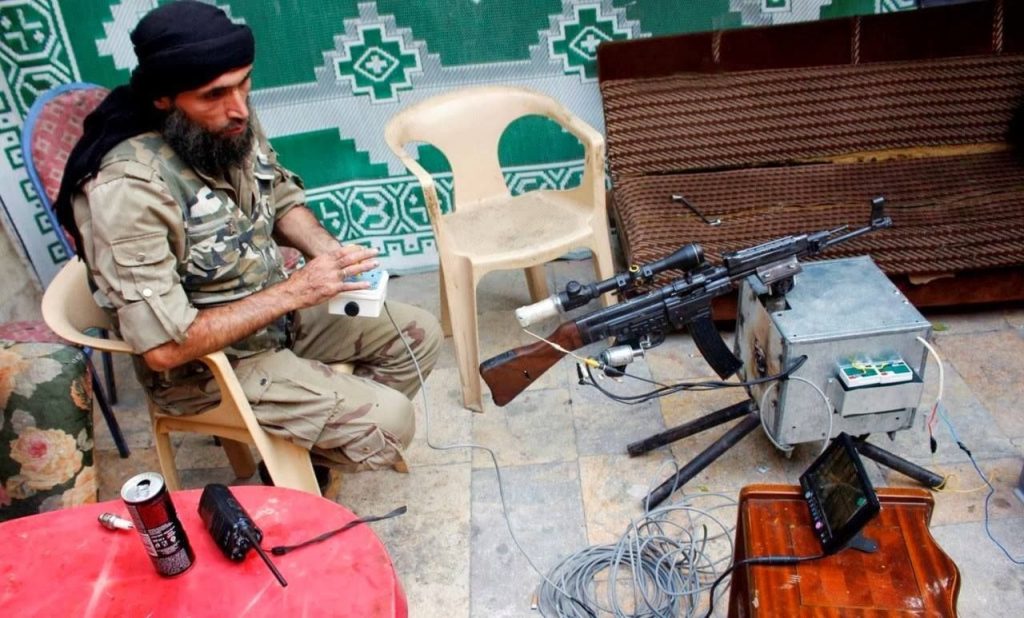
The FSA found crates of them in a Syrian Arab Army Depot and quickly put them into use. They must have found some 7.92x33mm ammo among the guns because they have been used by troops on the ground, rigged to remote firing stations, and beyond.
The STG 44 inspired the AK 47 and is largely considered the world’s first successful assault rifle. These select-fire rifles are somewhat compact, fed from a curved 30 round magazine. While it’s dated, it’s maybe only a step away from the AK 47’s usefulness. How these relics got to Syria in the first place is curious, but I imagine they’ve been there since shortly after the end of World War II.
Steyr AUG
The Steyr AUG is one of my favorite bullpup rifles. It’s an old-school model and has been utilized widely by European forces and even Homeland Security. The Steyr AUG popping up in Syria is a fascinating development. The examples found in Syria had serial numbers removed, so tracking them could be near impossible.
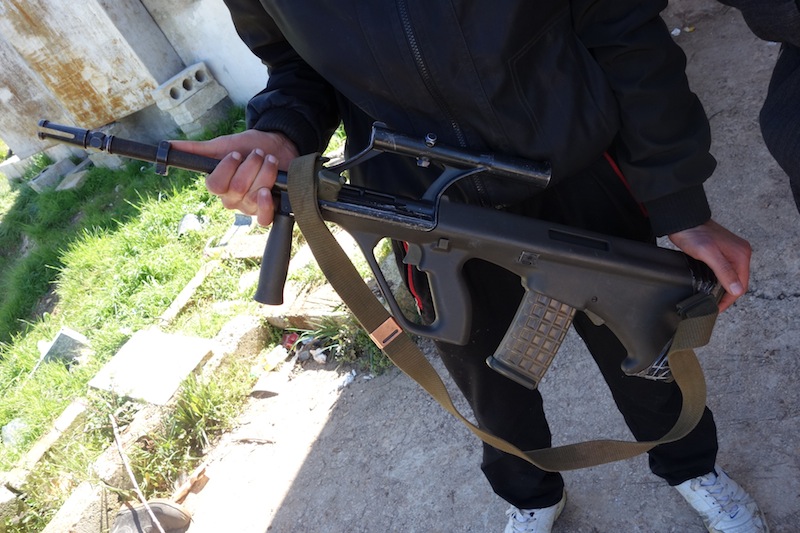
The Steyr AUG comes from Austria, which in the modern age vigorously combats leaking weapons into criminal hands. As a part of western Europe, they tend to be selective of who can purchase firearms and aren’t going to be selling firearms to the Free Syrian Army or to Assad.
As a rifle, it’s a damn fine one, but in a western setting, it’s still part of the weird weapons category. It’s a bullpup; it uses tons of polymer, often has a built-in optic, and generally gives those retro-future vibes.
Vickers Machine Gun
You thought the oldest of our weird weapons would be the STG 44, huh? Well, you’d be wrong, since mother truckin Vickers guns have been seen in the Syrian conflict. The Vickers gun was first made in 1912 and saw massive use in World War 1. The Vickers clung around for decades after the first World War.
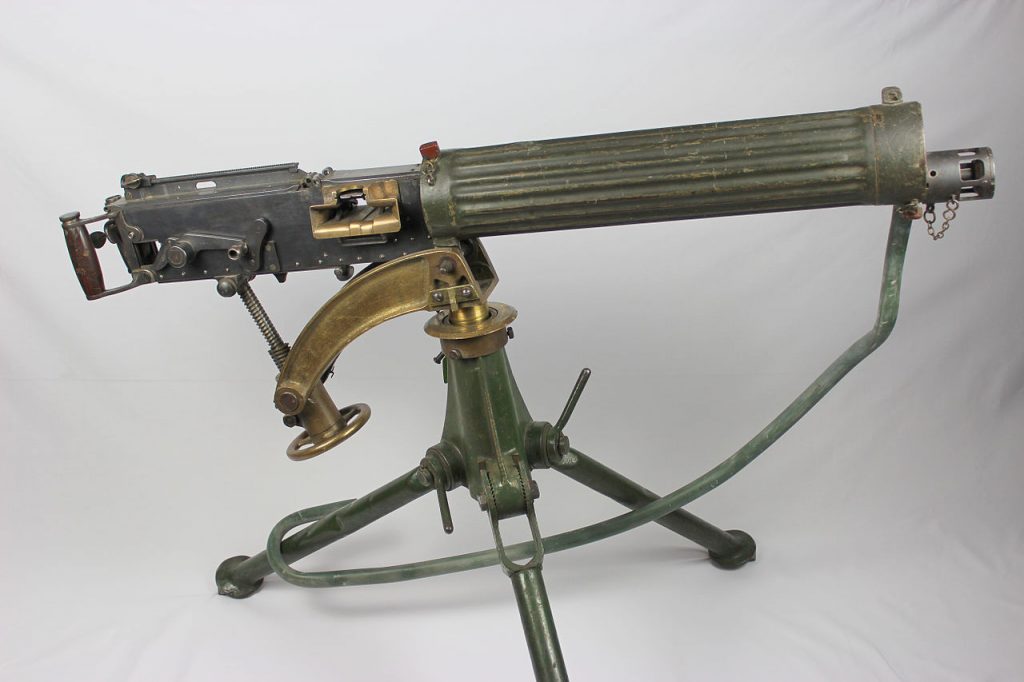
The Vickers Machine gun has been chambered in a wide variety of calibers, including the .303 British, .30-06, 11mm Vickers, and many more. The gun likely found its way to Syria during the numerous European expeditions into the Middle East. There are dozens of different conflicts, expeditions, and wars in which a Vickers could’ve landed in Syria.
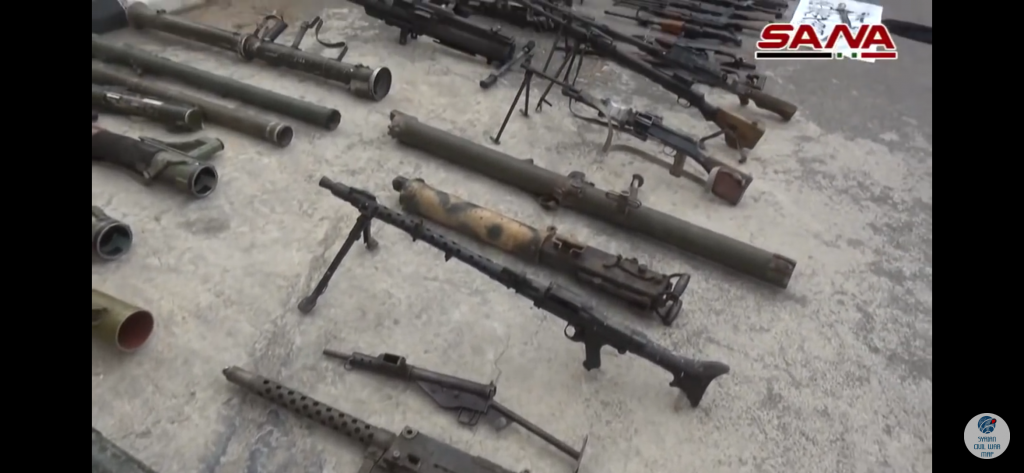
The Vickers Machine Gun came from the days when medium machine guns weighed 50 pounds and used water jackets to keep the barrels cool. These tripod-only guns are not great for maneuver warfare, but when you’re involved in a civil war in Syria, you take what you can get.
VZ 58
Don’t call it an AK! Those cheeky Czechs were forced into the Warsaw Pact but didn’t want the AK. Instead, they made the VZ 58, which admittedly resembles the AK series of rifles, and even utilizes the same caliber as the 47 series AK. However, other than that, it doesn’t have much in common with an AK.
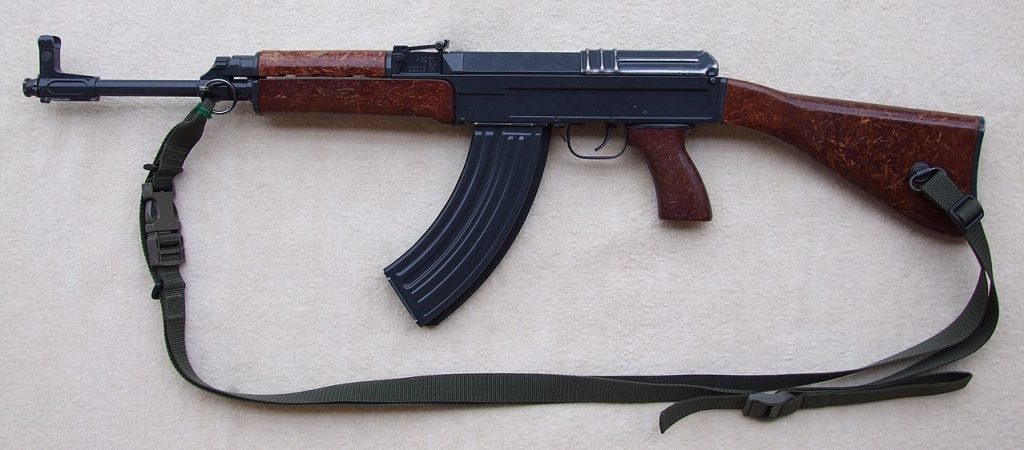
The ole 58 is a weird weapon. It’s one of the rare assault rifles to use a gas-operated falling breech block system to function and fire. The VZ 58 has proven itself to be a damn fine rifle. Unlike the AK, it’s not a widespread rifle. No one seems to know how the VZ 58 got to Syria, but they see action.
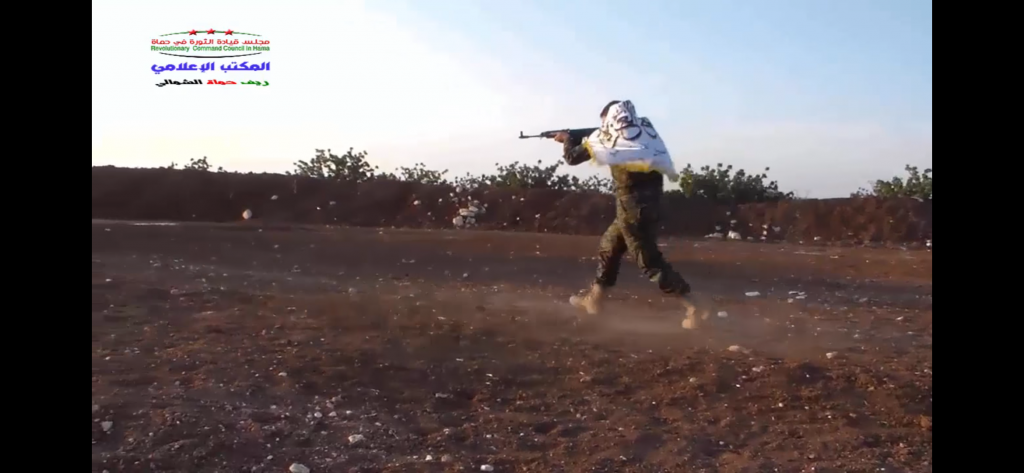
While they might use proprietary magazines, the VZ 58s use the common 7.62x39mm round. It helps logistically for forces full of 7.62×39 ammunition. The VZ 58 is another one of the mysterious origin weird weapons that have drifted into ancient Syria.
The W85
Is China doing shady things in different parts of the world? Say it isn’t so! This article could be all Chinese weapons because there seem to be lots of them in Syria. From M16 clones to the big ole W85. The W85 makes the list because it’s oddly common in Syria. It’s a heavy, 50 caliber machine gun that is essentially a modernized version of the Russian DShK.
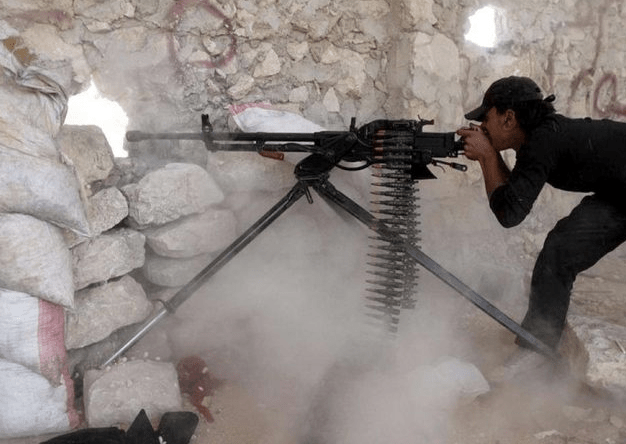
The W85 seems to be more common than an actual Russian DShK in Syria. As far as weird weapons go, their presence is weird, but their commonality is perhaps weirder. It’s a mighty powerful weapon. Syrians mount them on technicals, on tripods, and just randomly mounted to walls.
The W85 provides the Free Syrian Army a lot of firepower. It can defeat most light armored vehicles and lay down hate at extremely long ranges. A lot of these battles are in urban environments, and the W85 allows Syrians to eliminate the prospect of cover for most soldiers.
What Else?
This is five of a massive list of weapons we’ve seen in the Syrian civil war and only encapsulates the small arms of Syria. We aren’t even looking at the presence of a British tank, U.S. TOW launchers and missiles, and Nazi Germany anti-air guns. This conflict seems to be a bizarre combination of weird weapons, varied belligerents, and brutal battles.
Editor’s Note: Our own civil war, a binary conflict, has jaded us to what a civil war should look like. Many are confused that there are more than two sides, more than two main teams. We also discount the facts that the major world players of the day participated in our civil war the way powers today are meddling in Syria and elsewhere. We pretend that a global economy and a global society are new, but they are not. The speed of information and personnel movements are, but not the worldwide meddling. That’s older than the 13 colonies.
Magnum Research MR1911 10mm
This pistol came about part by chance and part by events leading up to it. I have been favorably impressed by pistols manufactured by Bul LLC and marketed in America as the Desert Eagle 1911. These pistols are now simply called the Magnum Research 1911.
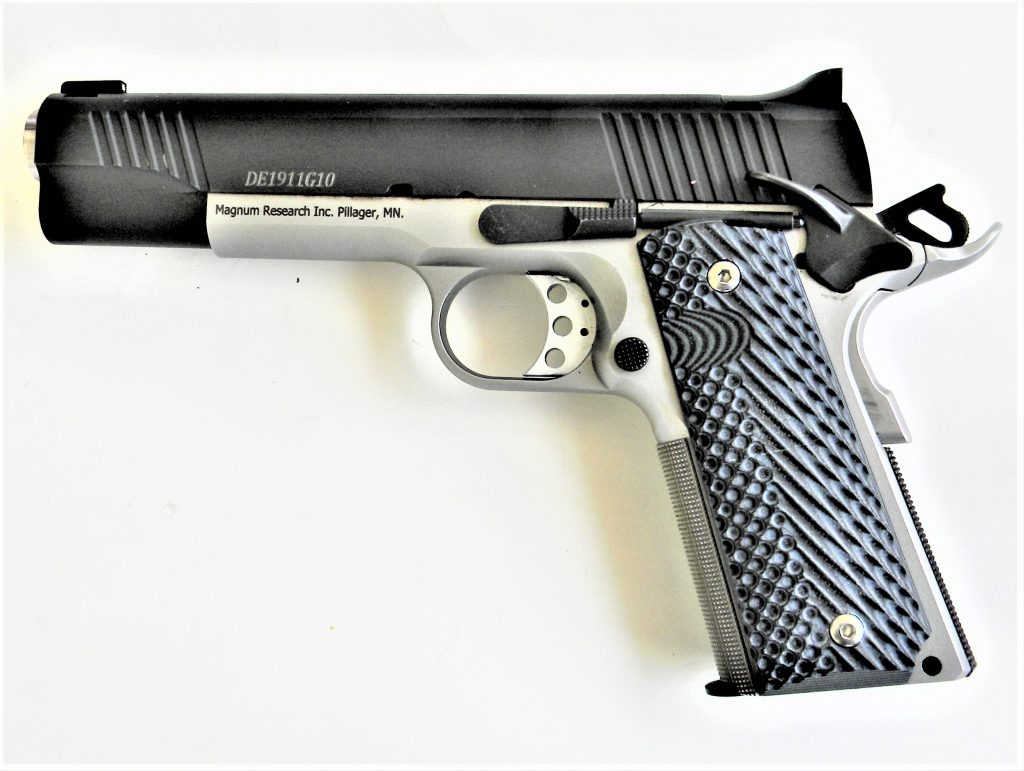
There was nothing wrong with the Desert Eagle pistols but since Kahr purchased Magnum Research it seems quality may be up a notch. I like the new layout, finish, and markings. I have enjoyed excellent performance from the MR1911 .45. When I ran across a used MR1911G10 at a fair price I thought I would give the 10mm a try. I have tried to like the 10mm but things have gotten in the way. The excellent performance of several .45s and a fascination with the .38 Super are among these distractions.
The original Colt 10mm 1911 was ok but the recoil system was a poor design that resulted in battering, and cracked frames in extreme cases. Colt eventually fixed these problems and is credited with saving the 10mm from obscurity. I won’t comment on the Bren Ten debacle, it is a thrice told tale.
The problem with 10mm reliability is that the pistol must have proper recoil springs and a heavy hammer spring. Some re-design is needed to shoehorn a high velocity cartridge into a handgun designed for a low pressure cartridge. The 10mm is intended to offer greater velocity, penetration, and range over the .45. That is a key as handguns are intended for short range use. It is difficult to better the .45 ACP for personal defense. For hunting and use at 50 yards the 10mm has an advantage. I have tried two 10mm handguns in the past few years that more or less served well. The Ruger 10mm is a good performer but beat me up with recoil. I suspect the recoil spring was too light. It ran well with all loads including some in the .40 S & W velocity range. The Kimber 10mm seemed to recoil less but choked on light loads. It ran well with full power loads.
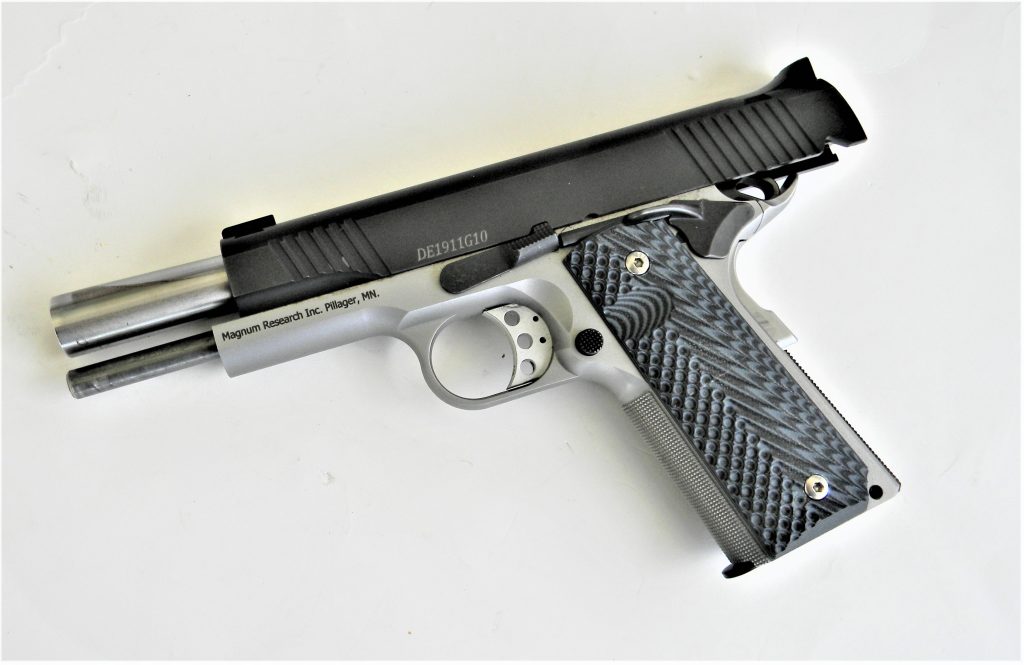
The new Magnum Research has a proper recoil spring and full power hammer spring.
The pistol has several features that differ from the usual 1911. The barrel features a bushingless lockup. The 1911 barrel bushing is a good design but when it comes to the greater slide velocity of the 10mm cartridge bushingless lockup works better. The belled barrel mates directly to the slide. This is a ramped design eliminating the original 1911 two piece feed ramp. The recoil assembly is a full length guide rod, required by a bushingless lockup.
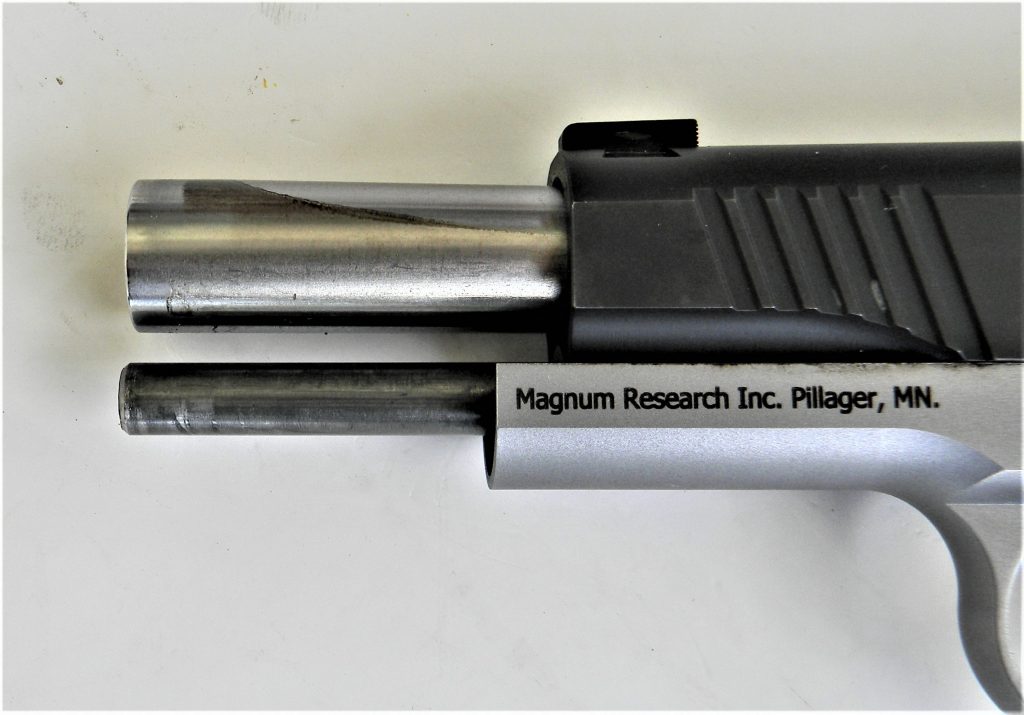
Take down is slightly complicated, although you may also break down the slide assembly in one piece for routine cleaning. Another advantage of the full length guide rod is that when you butt the pistol against a barricade the full length guide rod will prevent the pistol from going out of battery. The pistol may be less likely to be knocked out of battery in some situations.
The sights are good high profile types. The G10 scale grips offer a good balance of adhesion and abrasion. The pistol frame features a dip behind the trigger guard that lowers the bore axis. The front strap is nicely checkered. The beavertail is good design that properly releases its grip on the trigger about half way into compression. Trigger compression is a smooth consistent 4.9 pounds. I find this ideal for general purpose and personal defense use.
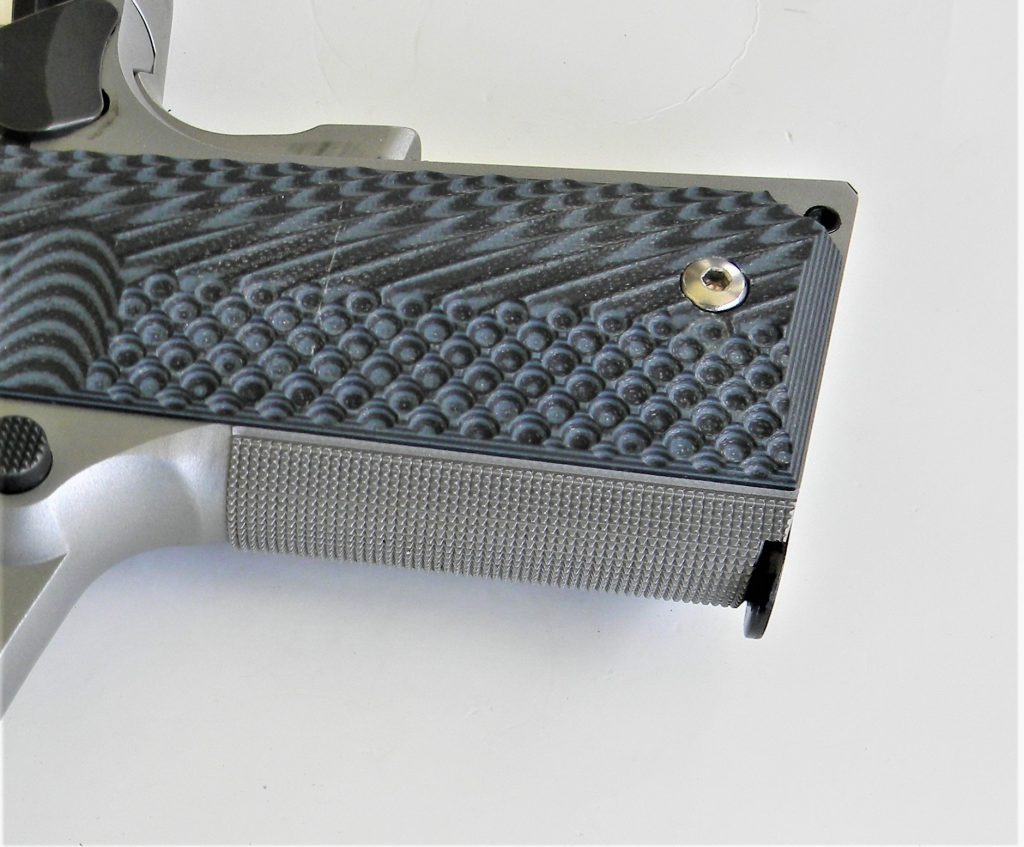
Grip strap checkering is well done. 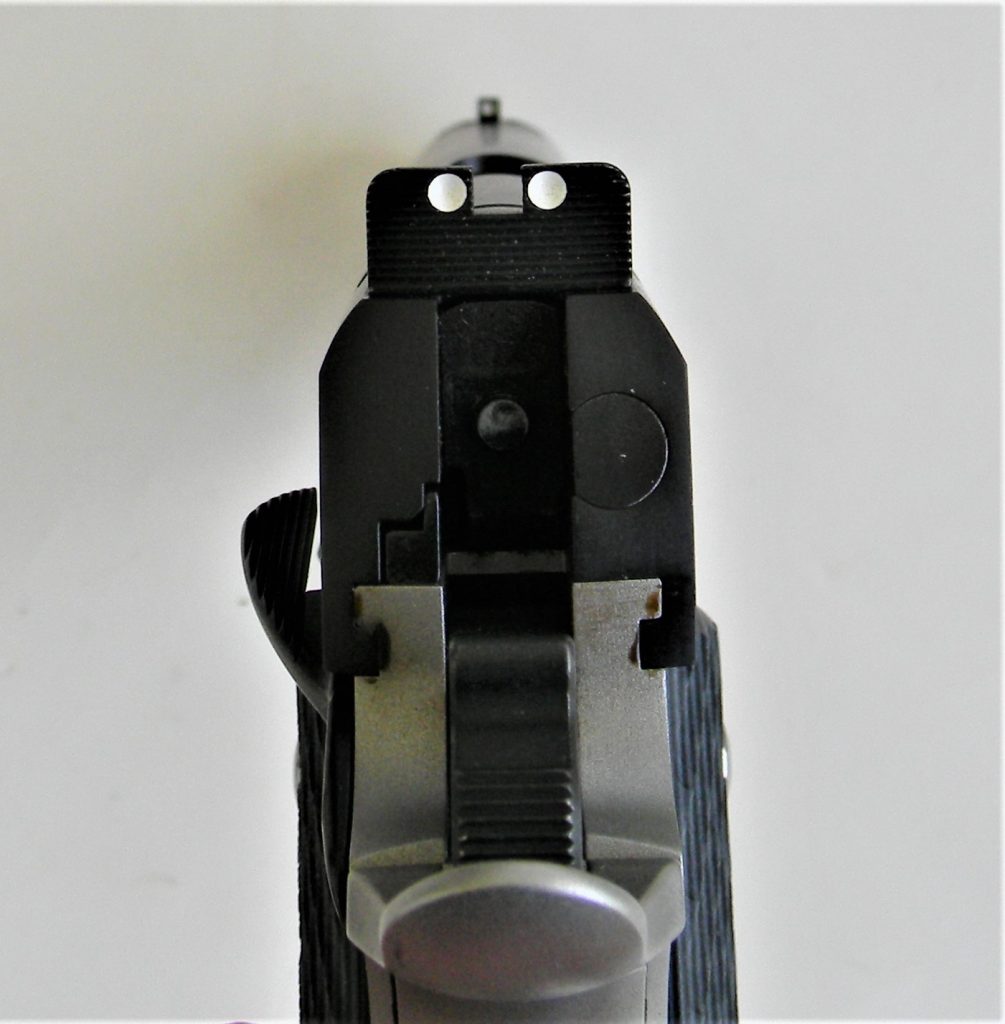
Three dot sights offer a good aiming point.
In the midst of this panic driven shortage folks like us that like to shoot a lot are the ones hurt the most. I was able to find several types of 10mm ammunition but none I have traditionally used. There was no Federal, Hornady, Buffalo Bore or Winchester on the shelf. I located some PPU, Georgia Arms, and two types of PMC.
And you know what they all ignited and functioned just fine. As I mentioned the pistol was comfortable to fire. All loads fed, chambered, fired ejected normally. Combat results were good- excellent, really. You have to remember the horsepower you are dealing with. The cadence of fire is dictated by how quickly you are able to recover the sight picture and get back on target. If you fire too quickly after trigger reset you will fire high.
The 10mm isn’t as fast as a .45 in addressing multiple targets but what is hit stays hit. I used the two supplied 8 rounds magazines and an additional Wilson Combat 9 round magazine, all with good function. So far I have expended 220 rounds with good results. Combat accuracy is there and the pistol is reliable. As for accuracy the 10mm isn’t renowned for accuracy potential. Just the same the pistol is accurate enough for most chores including taking deer sized game to 35 yards or so.
I fired several loads for accuracy. Firing from a solid benchrest using the MTM K Zone shooting rest. Recoil is more noticeable firing from a braced position. The pistol was a pleasure to use, however, recoil was simply more noticeable. At 20 yards the PMC FMJ and JHP loads each averaged 3.0 inches for five shots while the PPU FMJ loading went into 2.0 inches. Georgia Arms remanufactured loads averaged 2.4 inches. This is accuracy enough for most chores.
The pistol will probably be carried as a hiking and woods gun. Bears are not really a problem although there are plenty not far from my home. The big cats, feral dogs, and our protein fed ex-con criminal class are my primary concern. I have a Bullard Leather basketweave holster that rides high and offers a sharp draw.
The Magnum Research 1911 and the 10mm have grown on me.



